David Simon's Blog, page 20
July 16, 2016
An Invitation ... Israel Tour 2018
Israel is amazing! I have just arrived home from my third trip to the Promised Land. My daughters and I visited Tel-Aviv, Jerusalem, and areas in between. The trip inspired me to share the biblical sites, the archeology, the people and their culture with others. For this reason, I want to invite you to come with me to Israel in June 2018. (more below)Our current trip was mostly on our own. Sarah participated in a dig at Tel Gezer. Chelsea is now digging at Dan. Both digs are an immersion in discovery and learning about the people of the Bible. Sarah and Chelsea examined pottery, minerals, construction types and geology, and in the process learned about the people who left these items behind. During the time in-between digs we experienced Israel as a family. Sarah took us to Gezer, where we picked up and handled pottery from the days of Joshua and before. We looked at a fortress built by the Hasmoneans and re-used 250 years later by Simon Bar-Kochba who dug underground tunnels. We explored Latroun Hill, the location of many fierce battles.Four days of our trip were spent in Joppa enjoying the food and visiting biblical, archeological and historic sites. Our time in Jaffa also included swimming in the Mediterranean, shopping in the flea market, visiting parks, and meeting people from around the world. We visited archeological ruins under the plaza at Joppa where we saw a great audio-visual-sensory presentation. We toured the Eretz Israel Museum at Tel Aviv University along with the ruins of Tel Qasile and exhibits on traditions of the Jewish people. The Haganah Museum and Jewish Independence Hall were also included in our trip. We also went shopping at the Flea Market.After our visit to Tel-Aviv we spent five days in Jerusalem. On the first day I visited Hebrew University on Mount Scopos. The setting of the University provides a fantastic panoramic view of Jerusalem and surrounding area. The campus has an archeological museum we visited, and also discovered well preserved tombs from New Testament times in the Israeli Gardens which include the burial site of Nicanor of Alexandria. We also participated in the Temple Mount Sifting project. Chelsea, Sarah and I visited Ein Karem [the traditional home town of John the Baptist], St. Mark’s Church {the oldest Christian place of worship], and the Tower of David Museum at the Jaffa Gate.During our time in Jerusalem David Ilan guided us to various sites in and around the city. He told us of the archeological digs in the area. We visited the Wohl Museum under the Jewish Quarter and the Western Wall Tunnels. We viewed aqueducts, pools, and water tunnels. Our group explored local markets, neighborhoods and organizations. Every time I visit Israel I discover something old … but new to me. The Bible story becomes even more alive as I walk through the land and hear stories which help me to relate to the people.
Join me next timeCan a walk in Israel change your life? I am planning a trip in 2018, probably in June. To accomplish this I need 45 people who will travel with me to Israel. The cost will be about $5,000 per person (start saving money now)! … Let me know you are interested … and I will put you on the mailing list (no obligation at this point).I will let you know through e-mails the steps in the planning process. If you are interested, you can help confirm the date (June 2018), or help set another date. I will be asking along the way what you want to see in Israel. Over the next year (until March 2017) I will be collecting ideas in order to plan. Then I will be talking to an experienced tour leader who will help put the trip together. (The price and plans will be complete about a year before the trip). My e-mail is KosherCopy@gmail.com. (Write to let me know you are interested, or to ask questions).I will let you know of other plans as they develop, such as a potential add-on dig in the land. Or an add-on side trip. As I say, what I need now is interested people (no obligation) and ideas.
Join me next timeCan a walk in Israel change your life? I am planning a trip in 2018, probably in June. To accomplish this I need 45 people who will travel with me to Israel. The cost will be about $5,000 per person (start saving money now)! … Let me know you are interested … and I will put you on the mailing list (no obligation at this point).I will let you know through e-mails the steps in the planning process. If you are interested, you can help confirm the date (June 2018), or help set another date. I will be asking along the way what you want to see in Israel. Over the next year (until March 2017) I will be collecting ideas in order to plan. Then I will be talking to an experienced tour leader who will help put the trip together. (The price and plans will be complete about a year before the trip). My e-mail is KosherCopy@gmail.com. (Write to let me know you are interested, or to ask questions).I will let you know of other plans as they develop, such as a potential add-on dig in the land. Or an add-on side trip. As I say, what I need now is interested people (no obligation) and ideas.
Published on July 16, 2016 12:54
June 22, 2016
Israel Adventure - Day 13
We began today in our neighborhood with coffee and bagels at Bagel Cafe.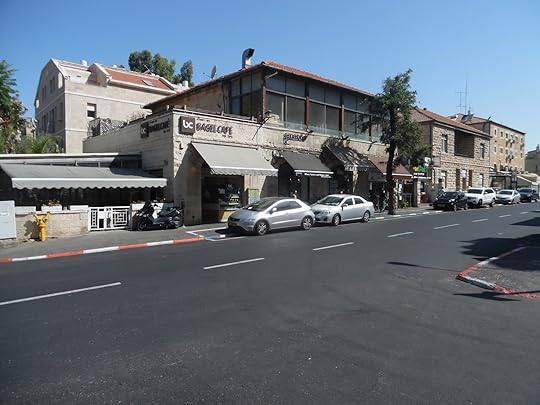 After breakfast we took the bus to the Albright Institute in Jerusalem. This institution helps facilitate archaeological research. They have fellowships and housing for graduate (PhD level) students in order to assist in research. We received a tour of the facility which included a library.
After breakfast we took the bus to the Albright Institute in Jerusalem. This institution helps facilitate archaeological research. They have fellowships and housing for graduate (PhD level) students in order to assist in research. We received a tour of the facility which included a library.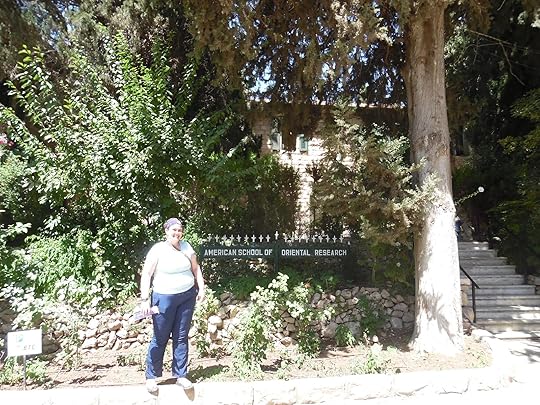 Following the Albright Institute we walked to the Rockefeller Archaeological Museum. Inside we found a great collection of pottery, artifacts, architecture, and even skeletal remains of people which have been found in Israel. We spent some time there and took lots of pictures.
Following the Albright Institute we walked to the Rockefeller Archaeological Museum. Inside we found a great collection of pottery, artifacts, architecture, and even skeletal remains of people which have been found in Israel. We spent some time there and took lots of pictures.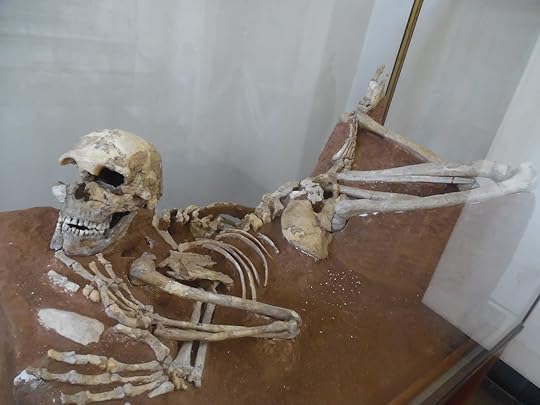
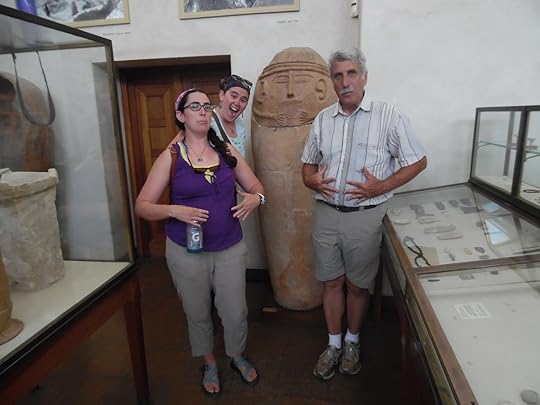 Then we were on our own. The Rockefeller Museum is across from the Old City at Herod’s Gate, so we crossed the street. We did not go in Herod’s Gate because I got lost there on my first day in Jerusalem. Instead, we walked around the city towards the Jaffa Gate.On the way to the Jaffa Gate we passed Zedekiah’s Cave. Tradition says the last king of Judea, Zedekiah, used this cave to escape the Babylonians. Some think Jeremiah hid the Ark of the Covenant here … but a complete search has been made, and it was not found. Jeremiah probably hid the Ark in another cave more directly under Temple Mount. The limestone hills of Judea are filled with many caves.
Then we were on our own. The Rockefeller Museum is across from the Old City at Herod’s Gate, so we crossed the street. We did not go in Herod’s Gate because I got lost there on my first day in Jerusalem. Instead, we walked around the city towards the Jaffa Gate.On the way to the Jaffa Gate we passed Zedekiah’s Cave. Tradition says the last king of Judea, Zedekiah, used this cave to escape the Babylonians. Some think Jeremiah hid the Ark of the Covenant here … but a complete search has been made, and it was not found. Jeremiah probably hid the Ark in another cave more directly under Temple Mount. The limestone hills of Judea are filled with many caves.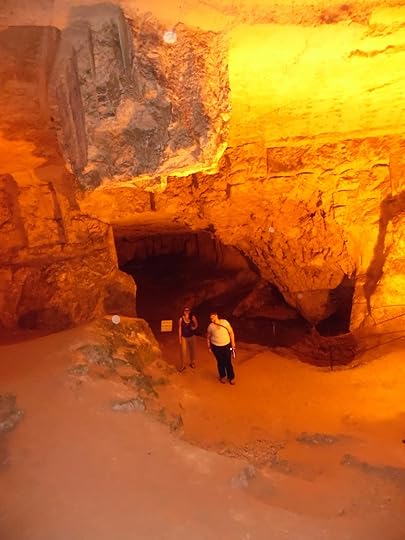 We enjoyed the cave since the day was very hot and the cave was cool.
We enjoyed the cave since the day was very hot and the cave was cool.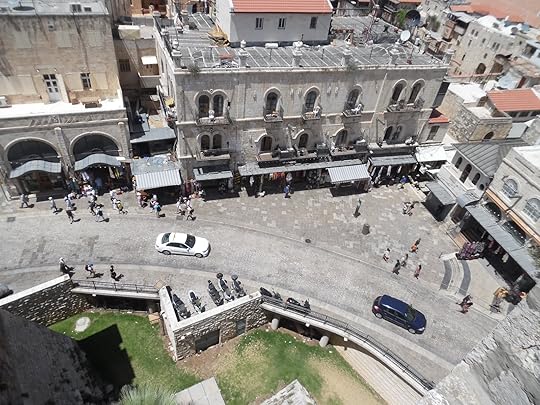 After departing the cave we went to the Jaffa Gate and to the Tower of David Museum. The museum is in a medieval fortress, or castle. Underneath the castle there are remains of King Herod’s palace from the time of Jesus. The museum contains the history of Jerusalem laid out in interesting fashion. There are lifelike displays which do not require much reading.
After departing the cave we went to the Jaffa Gate and to the Tower of David Museum. The museum is in a medieval fortress, or castle. Underneath the castle there are remains of King Herod’s palace from the time of Jesus. The museum contains the history of Jerusalem laid out in interesting fashion. There are lifelike displays which do not require much reading.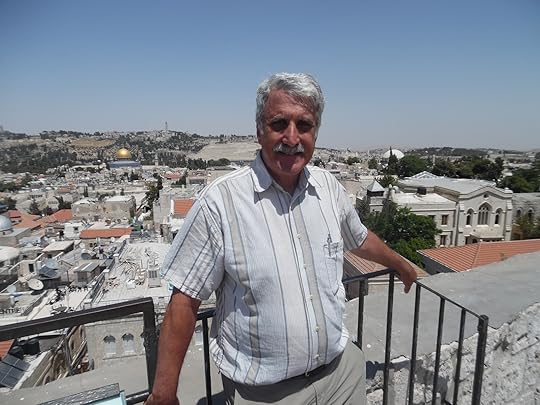 Above the museum there is a tower with a great view of the city. We spent some time looking, and then walking the ramparts.
Above the museum there is a tower with a great view of the city. We spent some time looking, and then walking the ramparts.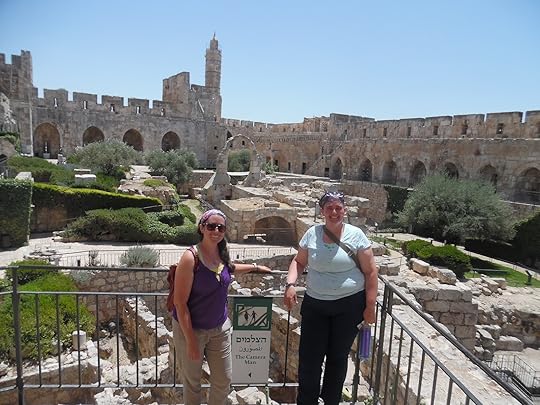 After our visit we stopped at Aroma Coffee for one last cup of Cookies and Cream frozen Coffee.
After our visit we stopped at Aroma Coffee for one last cup of Cookies and Cream frozen Coffee.
We walked through the park, and stopped at the Artist’s Colony. We saw some great artwork. The first artist we visited just placed a piece in the North Carolina Museum of Art. We saw several shops, and then returned home.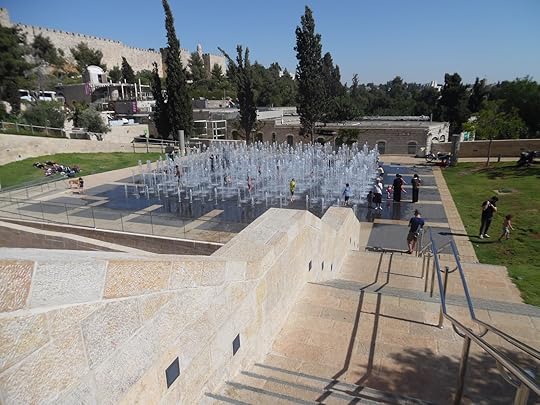 After packing (yes, it was our last day in Jerusalem) we went to Jerusalem’s First Train Station for dinner. We found a great place we had not tried before, and ate a full breakfast. This included eggs, bread, salad, and items for dipping and eating such as feta cheese, cream cheese, olives, guacamole, jelly and other dips.We arrived home and went to bed early since we had to meet our transportation to the airport at 3:45 a.m.
After packing (yes, it was our last day in Jerusalem) we went to Jerusalem’s First Train Station for dinner. We found a great place we had not tried before, and ate a full breakfast. This included eggs, bread, salad, and items for dipping and eating such as feta cheese, cream cheese, olives, guacamole, jelly and other dips.We arrived home and went to bed early since we had to meet our transportation to the airport at 3:45 a.m.
 After breakfast we took the bus to the Albright Institute in Jerusalem. This institution helps facilitate archaeological research. They have fellowships and housing for graduate (PhD level) students in order to assist in research. We received a tour of the facility which included a library.
After breakfast we took the bus to the Albright Institute in Jerusalem. This institution helps facilitate archaeological research. They have fellowships and housing for graduate (PhD level) students in order to assist in research. We received a tour of the facility which included a library. Following the Albright Institute we walked to the Rockefeller Archaeological Museum. Inside we found a great collection of pottery, artifacts, architecture, and even skeletal remains of people which have been found in Israel. We spent some time there and took lots of pictures.
Following the Albright Institute we walked to the Rockefeller Archaeological Museum. Inside we found a great collection of pottery, artifacts, architecture, and even skeletal remains of people which have been found in Israel. We spent some time there and took lots of pictures.
 Then we were on our own. The Rockefeller Museum is across from the Old City at Herod’s Gate, so we crossed the street. We did not go in Herod’s Gate because I got lost there on my first day in Jerusalem. Instead, we walked around the city towards the Jaffa Gate.On the way to the Jaffa Gate we passed Zedekiah’s Cave. Tradition says the last king of Judea, Zedekiah, used this cave to escape the Babylonians. Some think Jeremiah hid the Ark of the Covenant here … but a complete search has been made, and it was not found. Jeremiah probably hid the Ark in another cave more directly under Temple Mount. The limestone hills of Judea are filled with many caves.
Then we were on our own. The Rockefeller Museum is across from the Old City at Herod’s Gate, so we crossed the street. We did not go in Herod’s Gate because I got lost there on my first day in Jerusalem. Instead, we walked around the city towards the Jaffa Gate.On the way to the Jaffa Gate we passed Zedekiah’s Cave. Tradition says the last king of Judea, Zedekiah, used this cave to escape the Babylonians. Some think Jeremiah hid the Ark of the Covenant here … but a complete search has been made, and it was not found. Jeremiah probably hid the Ark in another cave more directly under Temple Mount. The limestone hills of Judea are filled with many caves. We enjoyed the cave since the day was very hot and the cave was cool.
We enjoyed the cave since the day was very hot and the cave was cool. After departing the cave we went to the Jaffa Gate and to the Tower of David Museum. The museum is in a medieval fortress, or castle. Underneath the castle there are remains of King Herod’s palace from the time of Jesus. The museum contains the history of Jerusalem laid out in interesting fashion. There are lifelike displays which do not require much reading.
After departing the cave we went to the Jaffa Gate and to the Tower of David Museum. The museum is in a medieval fortress, or castle. Underneath the castle there are remains of King Herod’s palace from the time of Jesus. The museum contains the history of Jerusalem laid out in interesting fashion. There are lifelike displays which do not require much reading. Above the museum there is a tower with a great view of the city. We spent some time looking, and then walking the ramparts.
Above the museum there is a tower with a great view of the city. We spent some time looking, and then walking the ramparts. After our visit we stopped at Aroma Coffee for one last cup of Cookies and Cream frozen Coffee.
After our visit we stopped at Aroma Coffee for one last cup of Cookies and Cream frozen Coffee.
We walked through the park, and stopped at the Artist’s Colony. We saw some great artwork. The first artist we visited just placed a piece in the North Carolina Museum of Art. We saw several shops, and then returned home.
 After packing (yes, it was our last day in Jerusalem) we went to Jerusalem’s First Train Station for dinner. We found a great place we had not tried before, and ate a full breakfast. This included eggs, bread, salad, and items for dipping and eating such as feta cheese, cream cheese, olives, guacamole, jelly and other dips.We arrived home and went to bed early since we had to meet our transportation to the airport at 3:45 a.m.
After packing (yes, it was our last day in Jerusalem) we went to Jerusalem’s First Train Station for dinner. We found a great place we had not tried before, and ate a full breakfast. This included eggs, bread, salad, and items for dipping and eating such as feta cheese, cream cheese, olives, guacamole, jelly and other dips.We arrived home and went to bed early since we had to meet our transportation to the airport at 3:45 a.m.
Published on June 22, 2016 20:49
June 21, 2016
Israel Adventure - Day 12
Each morning on the way to breakfast I walk through the oldest modern Jerusalem subdivision. These homes were built in about 1860 to alleviate overcrowding in the walled city. Now they are an exclusive housing division located very close to the Old City.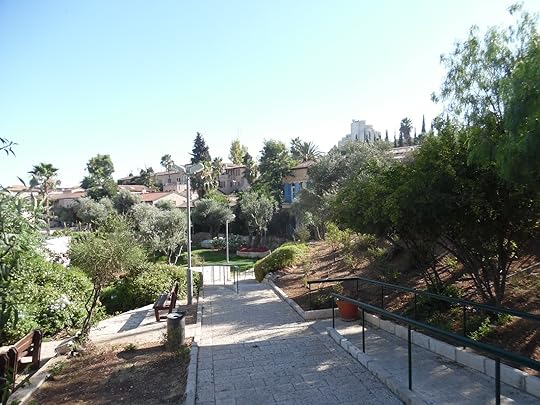 After breakfast at Aroma Coffee we joined our tour group this morning at Hebrew Union for a walk to the Jewish Quarter. We began the day with a tour under the Old City by the Western Wall of the Temple.
After breakfast at Aroma Coffee we joined our tour group this morning at Hebrew Union for a walk to the Jewish Quarter. We began the day with a tour under the Old City by the Western Wall of the Temple.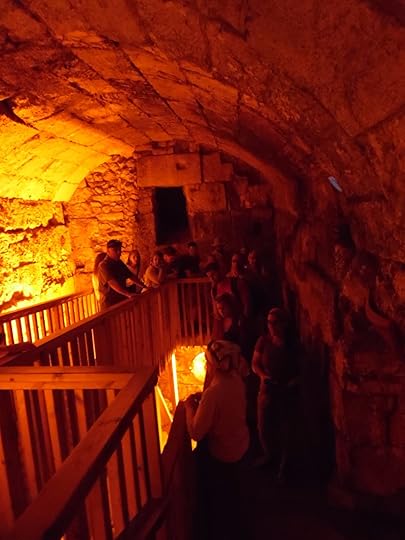 The tour began with a brief orientation by our tour guide, who recounted for us the history of Mount Moriah. During the time of Jesus the western side of Temple Mount faced a valley. Most of the priests lived on the other side, so they built a causeway over the valley. During the tour, we looked up at vaulted ceilings which are the bottom of that elevated path.After the destruction of the Temple the entire valley was filled with stone. After that the Arabs raised the city so they would not have to traverse a valley getting to the Dome of the Rock.
The tour began with a brief orientation by our tour guide, who recounted for us the history of Mount Moriah. During the time of Jesus the western side of Temple Mount faced a valley. Most of the priests lived on the other side, so they built a causeway over the valley. During the tour, we looked up at vaulted ceilings which are the bottom of that elevated path.After the destruction of the Temple the entire valley was filled with stone. After that the Arabs raised the city so they would not have to traverse a valley getting to the Dome of the Rock.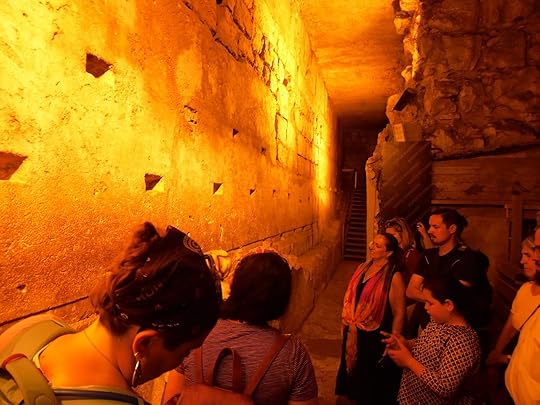 We approached the Western Wall at the largest block in the wall construction, which weighs 570 tons (45’ x 11” x 15’). Herod figured out how to move this block into place when he was building the Temple - an impressive task. The block was so heavy that when Titus gave the order to tear down the Western Wall, the Roman army could not move this massive piece of stone, so they started chipping away to try to decrease the size and weight. The progress of the Roman army’s attempts to knock down the walls can be see along the top and right side of the block, but they could not move the massive stone.
We approached the Western Wall at the largest block in the wall construction, which weighs 570 tons (45’ x 11” x 15’). Herod figured out how to move this block into place when he was building the Temple - an impressive task. The block was so heavy that when Titus gave the order to tear down the Western Wall, the Roman army could not move this massive piece of stone, so they started chipping away to try to decrease the size and weight. The progress of the Roman army’s attempts to knock down the walls can be see along the top and right side of the block, but they could not move the massive stone.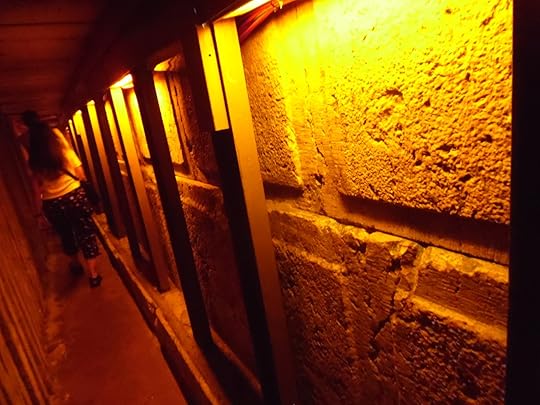 We walked along the wall to the north, which continued for about 150 meters. We saw typical Herodian stones along the wall. Each level of block was stepped back so the wall would not appear to be falling on the people as they looked upward toward the top. The pathway led downhill until we hit the bedrock. Because the Temple was built on bedrock that has a natural incline, the bedrock was cut down and became part of the stones - King Herod had the bedrock carved like the stone for consistency and quality. We reached the original street level and saw how roads were paved. Eventually we hit a spot along the path where we could see the other side of the street as it existed 2,000 years ago.
We walked along the wall to the north, which continued for about 150 meters. We saw typical Herodian stones along the wall. Each level of block was stepped back so the wall would not appear to be falling on the people as they looked upward toward the top. The pathway led downhill until we hit the bedrock. Because the Temple was built on bedrock that has a natural incline, the bedrock was cut down and became part of the stones - King Herod had the bedrock carved like the stone for consistency and quality. We reached the original street level and saw how roads were paved. Eventually we hit a spot along the path where we could see the other side of the street as it existed 2,000 years ago.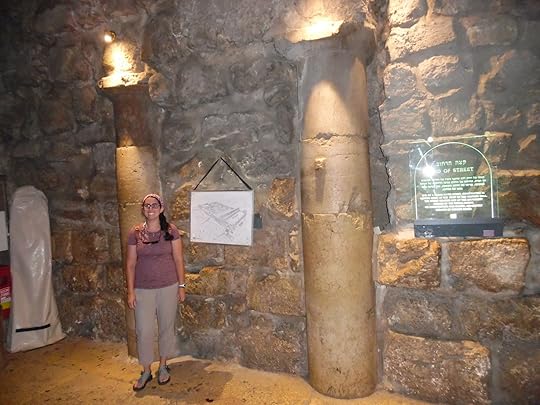 The path extended into the aqueduct and ended at a cistern developed for the Antonion fortress. Pictured in the cistern is our guide. Above is a block which is under homes and in the streets.
The path extended into the aqueduct and ended at a cistern developed for the Antonion fortress. Pictured in the cistern is our guide. Above is a block which is under homes and in the streets.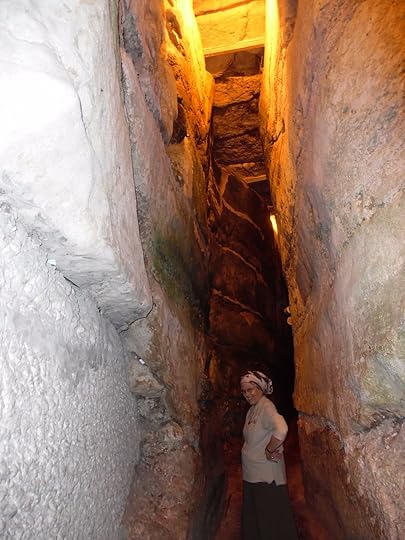 At the end of the tour we walked to the Jewish Quarter. The entrance of the tunnel is located at the Western Wall Plaza, so we walked past the Western Wall (although we did not go to the public part of the wall). The picture below shows the Western Wall as we are climbing. The Dome of the Rock is visible in this picture.
At the end of the tour we walked to the Jewish Quarter. The entrance of the tunnel is located at the Western Wall Plaza, so we walked past the Western Wall (although we did not go to the public part of the wall). The picture below shows the Western Wall as we are climbing. The Dome of the Rock is visible in this picture.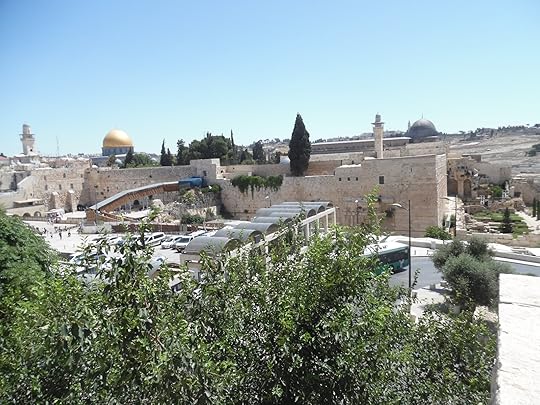 At the top of the stairs we stopped at a church and inn managed by the Teutonic Templar Knights. The church’s architecture was made in gothic style.
At the top of the stairs we stopped at a church and inn managed by the Teutonic Templar Knights. The church’s architecture was made in gothic style.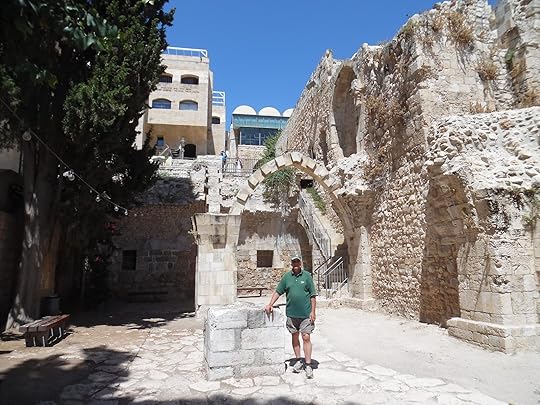 Next we went to the Wohl Museum of Herodian Archaeology which contains six homes from the time of Jesus. These are not normal homes, but the homes of the wealthy on top of new Mount Zion. This can be seen in the jars found at the site;
Next we went to the Wohl Museum of Herodian Archaeology which contains six homes from the time of Jesus. These are not normal homes, but the homes of the wealthy on top of new Mount Zion. This can be seen in the jars found at the site;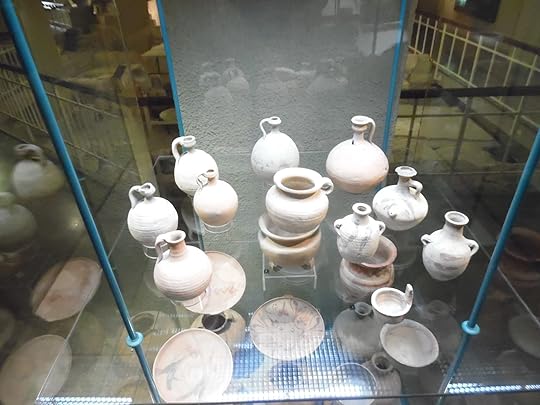 The mosaics seen in the houses;
The mosaics seen in the houses;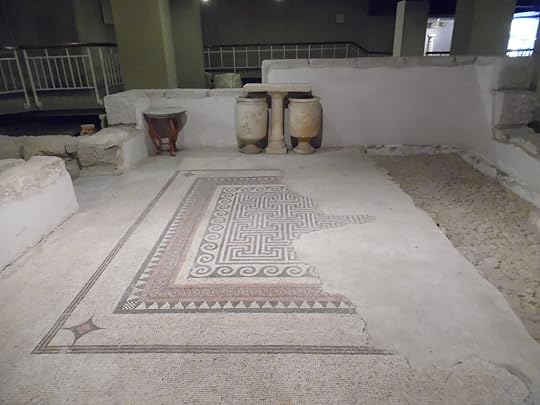 And the large mansion which may have belonged to the High Priest:
And the large mansion which may have belonged to the High Priest: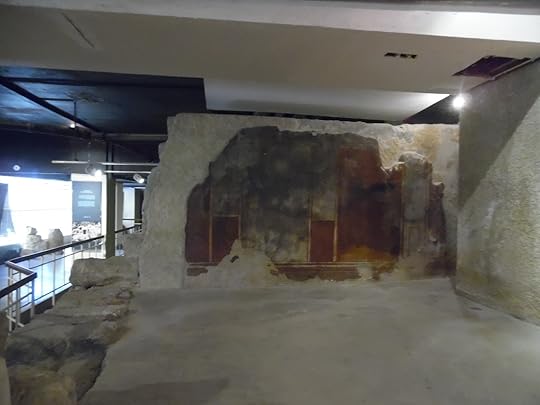 Dr. Ilan then took us outside and onto the Cardo which ran through Jerusalem from the Damascus Gate to the Zion Gate. This road is shown on the map at Madaba, Jordan. The street was wide with shops on each side. As we walked, we saw where the ruins were uncovered and could imagine where shops were set along the street according to the ancient style. As we walked further along the Cardo, Dr. Ilan pointed out where shop spaces became more modern and the street was not as wide. Eventually we came to the Muslim Quarter, where the streets are even narrower and more crowded.
Dr. Ilan then took us outside and onto the Cardo which ran through Jerusalem from the Damascus Gate to the Zion Gate. This road is shown on the map at Madaba, Jordan. The street was wide with shops on each side. As we walked, we saw where the ruins were uncovered and could imagine where shops were set along the street according to the ancient style. As we walked further along the Cardo, Dr. Ilan pointed out where shop spaces became more modern and the street was not as wide. Eventually we came to the Muslim Quarter, where the streets are even narrower and more crowded.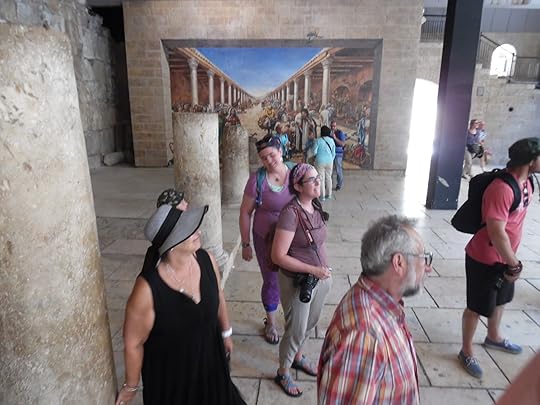 At this point we were released to see the city. The group went to eat lunch at a shawarma place (Kosher). We sat down and I met a man who went to school with Denise, proving that the world is a small place.We then went shopping, first stopping into Moshe Shorashim’s Shop, which we visited on our trips with John Delancey. (Please plan to go on a trip to Israel in 2018 with me, and see this shop. The trip will cost about $5,000 per person … let me know if you have any interest [no obligation] so I can put you on the mailing list.)As we left the city we saw the “traditional” Upper Room site and King David’s tomb.
At this point we were released to see the city. The group went to eat lunch at a shawarma place (Kosher). We sat down and I met a man who went to school with Denise, proving that the world is a small place.We then went shopping, first stopping into Moshe Shorashim’s Shop, which we visited on our trips with John Delancey. (Please plan to go on a trip to Israel in 2018 with me, and see this shop. The trip will cost about $5,000 per person … let me know if you have any interest [no obligation] so I can put you on the mailing list.)As we left the city we saw the “traditional” Upper Room site and King David’s tomb.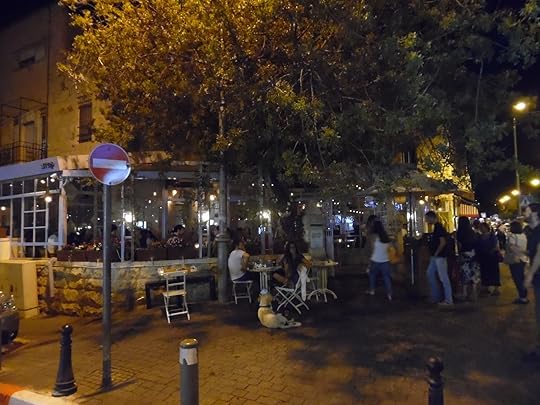 Our day finished with a great dinner of Salmon, sweet potato latkes, rice, and green beans at Caffit, a restaurant about a block from our apartment.
Our day finished with a great dinner of Salmon, sweet potato latkes, rice, and green beans at Caffit, a restaurant about a block from our apartment.
 After breakfast at Aroma Coffee we joined our tour group this morning at Hebrew Union for a walk to the Jewish Quarter. We began the day with a tour under the Old City by the Western Wall of the Temple.
After breakfast at Aroma Coffee we joined our tour group this morning at Hebrew Union for a walk to the Jewish Quarter. We began the day with a tour under the Old City by the Western Wall of the Temple. The tour began with a brief orientation by our tour guide, who recounted for us the history of Mount Moriah. During the time of Jesus the western side of Temple Mount faced a valley. Most of the priests lived on the other side, so they built a causeway over the valley. During the tour, we looked up at vaulted ceilings which are the bottom of that elevated path.After the destruction of the Temple the entire valley was filled with stone. After that the Arabs raised the city so they would not have to traverse a valley getting to the Dome of the Rock.
The tour began with a brief orientation by our tour guide, who recounted for us the history of Mount Moriah. During the time of Jesus the western side of Temple Mount faced a valley. Most of the priests lived on the other side, so they built a causeway over the valley. During the tour, we looked up at vaulted ceilings which are the bottom of that elevated path.After the destruction of the Temple the entire valley was filled with stone. After that the Arabs raised the city so they would not have to traverse a valley getting to the Dome of the Rock. We approached the Western Wall at the largest block in the wall construction, which weighs 570 tons (45’ x 11” x 15’). Herod figured out how to move this block into place when he was building the Temple - an impressive task. The block was so heavy that when Titus gave the order to tear down the Western Wall, the Roman army could not move this massive piece of stone, so they started chipping away to try to decrease the size and weight. The progress of the Roman army’s attempts to knock down the walls can be see along the top and right side of the block, but they could not move the massive stone.
We approached the Western Wall at the largest block in the wall construction, which weighs 570 tons (45’ x 11” x 15’). Herod figured out how to move this block into place when he was building the Temple - an impressive task. The block was so heavy that when Titus gave the order to tear down the Western Wall, the Roman army could not move this massive piece of stone, so they started chipping away to try to decrease the size and weight. The progress of the Roman army’s attempts to knock down the walls can be see along the top and right side of the block, but they could not move the massive stone. We walked along the wall to the north, which continued for about 150 meters. We saw typical Herodian stones along the wall. Each level of block was stepped back so the wall would not appear to be falling on the people as they looked upward toward the top. The pathway led downhill until we hit the bedrock. Because the Temple was built on bedrock that has a natural incline, the bedrock was cut down and became part of the stones - King Herod had the bedrock carved like the stone for consistency and quality. We reached the original street level and saw how roads were paved. Eventually we hit a spot along the path where we could see the other side of the street as it existed 2,000 years ago.
We walked along the wall to the north, which continued for about 150 meters. We saw typical Herodian stones along the wall. Each level of block was stepped back so the wall would not appear to be falling on the people as they looked upward toward the top. The pathway led downhill until we hit the bedrock. Because the Temple was built on bedrock that has a natural incline, the bedrock was cut down and became part of the stones - King Herod had the bedrock carved like the stone for consistency and quality. We reached the original street level and saw how roads were paved. Eventually we hit a spot along the path where we could see the other side of the street as it existed 2,000 years ago. The path extended into the aqueduct and ended at a cistern developed for the Antonion fortress. Pictured in the cistern is our guide. Above is a block which is under homes and in the streets.
The path extended into the aqueduct and ended at a cistern developed for the Antonion fortress. Pictured in the cistern is our guide. Above is a block which is under homes and in the streets. At the end of the tour we walked to the Jewish Quarter. The entrance of the tunnel is located at the Western Wall Plaza, so we walked past the Western Wall (although we did not go to the public part of the wall). The picture below shows the Western Wall as we are climbing. The Dome of the Rock is visible in this picture.
At the end of the tour we walked to the Jewish Quarter. The entrance of the tunnel is located at the Western Wall Plaza, so we walked past the Western Wall (although we did not go to the public part of the wall). The picture below shows the Western Wall as we are climbing. The Dome of the Rock is visible in this picture. At the top of the stairs we stopped at a church and inn managed by the Teutonic Templar Knights. The church’s architecture was made in gothic style.
At the top of the stairs we stopped at a church and inn managed by the Teutonic Templar Knights. The church’s architecture was made in gothic style. Next we went to the Wohl Museum of Herodian Archaeology which contains six homes from the time of Jesus. These are not normal homes, but the homes of the wealthy on top of new Mount Zion. This can be seen in the jars found at the site;
Next we went to the Wohl Museum of Herodian Archaeology which contains six homes from the time of Jesus. These are not normal homes, but the homes of the wealthy on top of new Mount Zion. This can be seen in the jars found at the site; The mosaics seen in the houses;
The mosaics seen in the houses; And the large mansion which may have belonged to the High Priest:
And the large mansion which may have belonged to the High Priest: Dr. Ilan then took us outside and onto the Cardo which ran through Jerusalem from the Damascus Gate to the Zion Gate. This road is shown on the map at Madaba, Jordan. The street was wide with shops on each side. As we walked, we saw where the ruins were uncovered and could imagine where shops were set along the street according to the ancient style. As we walked further along the Cardo, Dr. Ilan pointed out where shop spaces became more modern and the street was not as wide. Eventually we came to the Muslim Quarter, where the streets are even narrower and more crowded.
Dr. Ilan then took us outside and onto the Cardo which ran through Jerusalem from the Damascus Gate to the Zion Gate. This road is shown on the map at Madaba, Jordan. The street was wide with shops on each side. As we walked, we saw where the ruins were uncovered and could imagine where shops were set along the street according to the ancient style. As we walked further along the Cardo, Dr. Ilan pointed out where shop spaces became more modern and the street was not as wide. Eventually we came to the Muslim Quarter, where the streets are even narrower and more crowded. At this point we were released to see the city. The group went to eat lunch at a shawarma place (Kosher). We sat down and I met a man who went to school with Denise, proving that the world is a small place.We then went shopping, first stopping into Moshe Shorashim’s Shop, which we visited on our trips with John Delancey. (Please plan to go on a trip to Israel in 2018 with me, and see this shop. The trip will cost about $5,000 per person … let me know if you have any interest [no obligation] so I can put you on the mailing list.)As we left the city we saw the “traditional” Upper Room site and King David’s tomb.
At this point we were released to see the city. The group went to eat lunch at a shawarma place (Kosher). We sat down and I met a man who went to school with Denise, proving that the world is a small place.We then went shopping, first stopping into Moshe Shorashim’s Shop, which we visited on our trips with John Delancey. (Please plan to go on a trip to Israel in 2018 with me, and see this shop. The trip will cost about $5,000 per person … let me know if you have any interest [no obligation] so I can put you on the mailing list.)As we left the city we saw the “traditional” Upper Room site and King David’s tomb. Our day finished with a great dinner of Salmon, sweet potato latkes, rice, and green beans at Caffit, a restaurant about a block from our apartment.
Our day finished with a great dinner of Salmon, sweet potato latkes, rice, and green beans at Caffit, a restaurant about a block from our apartment.
Published on June 21, 2016 12:13
June 20, 2016
Israel Adventure - Day 11
This morning we started with an early fast breakfast from Aroma Coffee, and then a quick departure to the Old City. We began our tour with a walk around the perimeter of the walls to the south. Dr. Ilan showed us the different levels of the walls from the bedrock up. He showed us where the walls were at different places in different time periods. They were not as they appear today.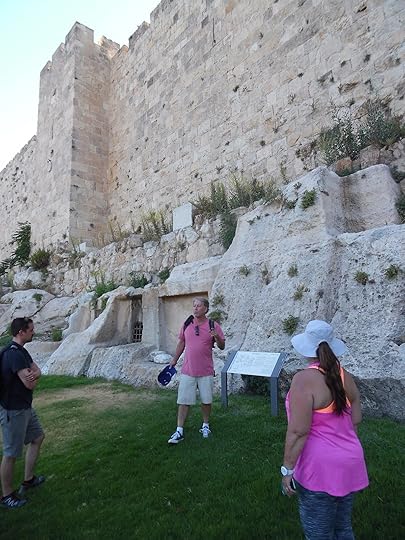 In the picture above bedrock can be seen below the walls (above the grass). There are tombs chiseled into the soft chalk bedrock, showing that at one time this area was outside of the city. There are rocks above the tombs from the Roman Period (130-443 AD). Above those rocks, and slightly inside, are walls built by Sultan Suleiman the Magnificent (1535 AD).
In the picture above bedrock can be seen below the walls (above the grass). There are tombs chiseled into the soft chalk bedrock, showing that at one time this area was outside of the city. There are rocks above the tombs from the Roman Period (130-443 AD). Above those rocks, and slightly inside, are walls built by Sultan Suleiman the Magnificent (1535 AD).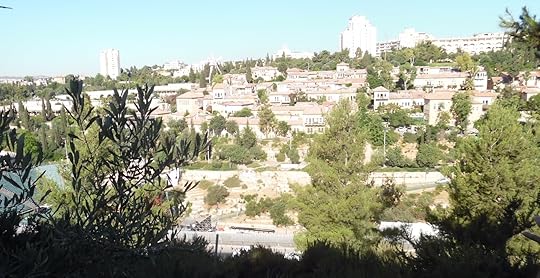 While we were standing by the wall, we looked across the Hinnom Valley. At the bottom of the valley is Sultan’s Pool, perhaps the Serpent Pool of Jesus’ time. This was part of the irrigation system for farms which lay below the city. Just above the pool is the old aqueduct which snakes around and into the city. Above that are homes built in 1860 - in a sense, Jerusalem’s first suburb.
While we were standing by the wall, we looked across the Hinnom Valley. At the bottom of the valley is Sultan’s Pool, perhaps the Serpent Pool of Jesus’ time. This was part of the irrigation system for farms which lay below the city. Just above the pool is the old aqueduct which snakes around and into the city. Above that are homes built in 1860 - in a sense, Jerusalem’s first suburb.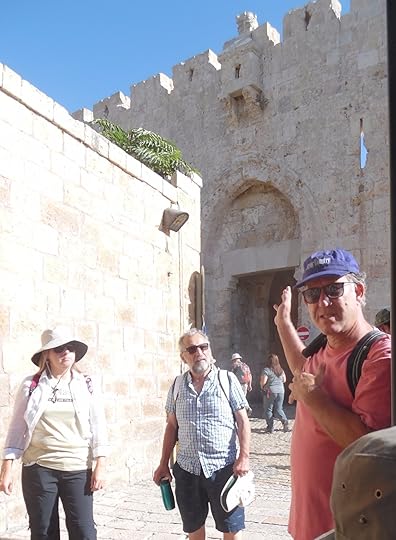 We then walked south to the Zion Gate. This was on the Green Line in 1948 and several fierce battles were fought here. The walls are pocketed with the bullet holes from shelling and battle.
We then walked south to the Zion Gate. This was on the Green Line in 1948 and several fierce battles were fought here. The walls are pocketed with the bullet holes from shelling and battle.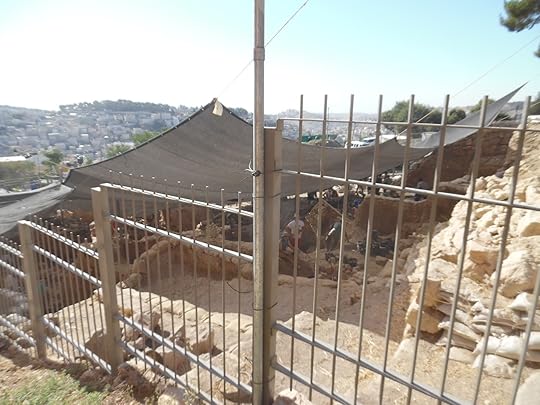 Continuing on the south wall, we passed a dig being done by UNCC (University of North Carolina Charlotte).
Continuing on the south wall, we passed a dig being done by UNCC (University of North Carolina Charlotte).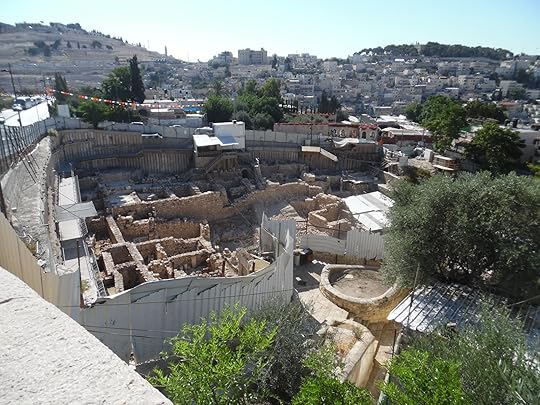 Further along our walk we saw this dig. Dr. Ilan told us this was originally a parking area which was to be developed as a five story parking garage. Israeli law requires that an archeological survey must be done before anything new can be built in Israel. When the survey was done, ruins were discovered from the Turkish period, then by digging, the Roman, Greek, Hasmonean, and earlier. This is not surprising because this area is near the Tyropoeon Valley or Cheesemaker’s Valley, which runs through the center of the city. Four years into the dig, the garage was cancelled and the archeological find was placed along a walking path which leads to the Temple.
Further along our walk we saw this dig. Dr. Ilan told us this was originally a parking area which was to be developed as a five story parking garage. Israeli law requires that an archeological survey must be done before anything new can be built in Israel. When the survey was done, ruins were discovered from the Turkish period, then by digging, the Roman, Greek, Hasmonean, and earlier. This is not surprising because this area is near the Tyropoeon Valley or Cheesemaker’s Valley, which runs through the center of the city. Four years into the dig, the garage was cancelled and the archeological find was placed along a walking path which leads to the Temple.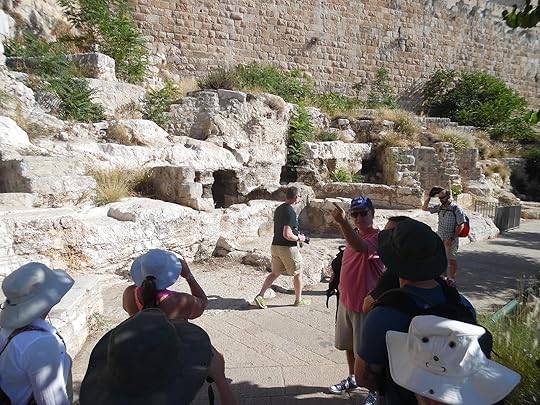 Further along the walls we saw more tombs cut into the bedrock. During the time of King David this area was inside the city, so the tombs must have come later. Jewish law forbids burial (except for kings) inside the city walls where people live. As the city walls move in and out and people necessarily come to live near the tombs, the Rabbis developed ways of ritually cleansing the tombs. Bones are removed and blessings are spoken so people can build on top of the tombs. That is what happened with these tombs, and they were refitted as cisterns with plaster on top, and houses above the plaster. The wall above the tombs is late period Ottoman.
Further along the walls we saw more tombs cut into the bedrock. During the time of King David this area was inside the city, so the tombs must have come later. Jewish law forbids burial (except for kings) inside the city walls where people live. As the city walls move in and out and people necessarily come to live near the tombs, the Rabbis developed ways of ritually cleansing the tombs. Bones are removed and blessings are spoken so people can build on top of the tombs. That is what happened with these tombs, and they were refitted as cisterns with plaster on top, and houses above the plaster. The wall above the tombs is late period Ottoman.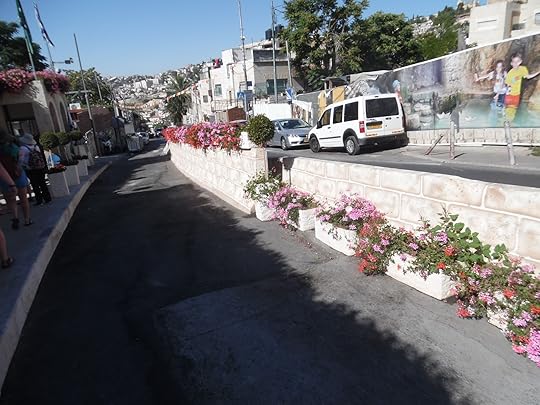 Along the way we saw these concrete road barriers (like are being installed on I-77). I wonder why we can’t make them look this good in America?
Along the way we saw these concrete road barriers (like are being installed on I-77). I wonder why we can’t make them look this good in America?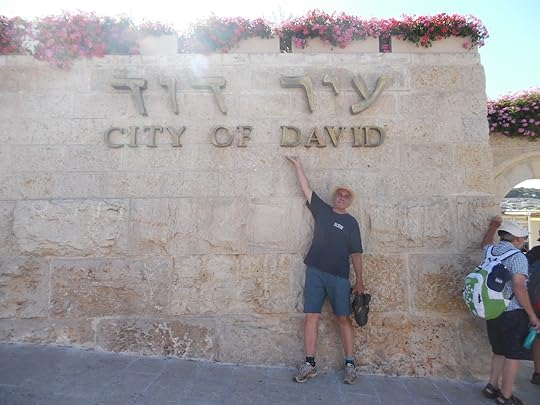 We came to the Old City of David (currently outside the walls of the city) where the Gihon spring is located. One objective of the day was to descend to the spring and see the ancient fortifications.We walked through the upper ruins, where the excavator thinks King David’s palace is located.
We came to the Old City of David (currently outside the walls of the city) where the Gihon spring is located. One objective of the day was to descend to the spring and see the ancient fortifications.We walked through the upper ruins, where the excavator thinks King David’s palace is located.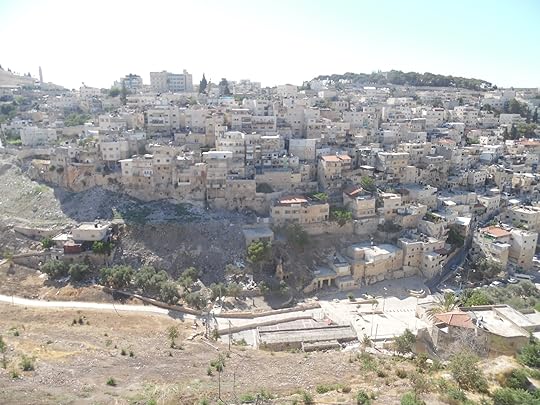 This is Silwan, a neighborhood across the Kidron Valley from the City of David. In Biblical times Jerusalem looked much like this with the palace at the top (which is why David could look down and see Bathsheba on the rooftop).
This is Silwan, a neighborhood across the Kidron Valley from the City of David. In Biblical times Jerusalem looked much like this with the palace at the top (which is why David could look down and see Bathsheba on the rooftop). 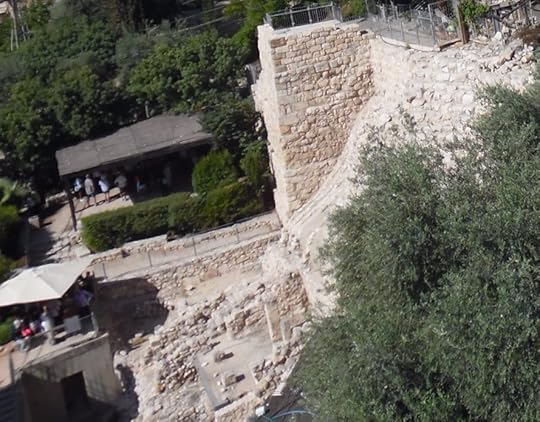 Today the hillside looks like this, with remains of structures at the bottom. Some of the residents at the bottom of the hill are listed in the book of Jeremiah. The houses on this hillside go back to the time of King David, so people lived on this hillside for 500 years. Dr. Ilan talked about how difficult archeology and dating become when people can live in peace in an area for so long, without destruction levels to help date the civilization.
Today the hillside looks like this, with remains of structures at the bottom. Some of the residents at the bottom of the hill are listed in the book of Jeremiah. The houses on this hillside go back to the time of King David, so people lived on this hillside for 500 years. Dr. Ilan talked about how difficult archeology and dating become when people can live in peace in an area for so long, without destruction levels to help date the civilization.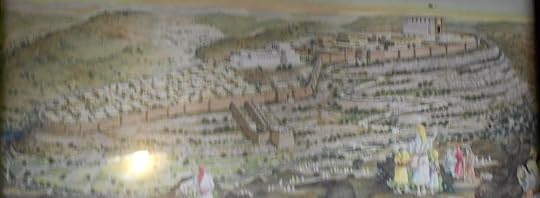 This blurred picture is what the city of David probably looked like. The Temple is at the top of the hill, the palace (Solomon’s) at the mid-section. The path to the Temple can be seen winding up the hill. The Gihon Spring can be seen just below the shine on the bottom left of the picture. This spring was fortified behind strong walls in order to protect the city’s water source. We walked down to Gihon Spring.
This blurred picture is what the city of David probably looked like. The Temple is at the top of the hill, the palace (Solomon’s) at the mid-section. The path to the Temple can be seen winding up the hill. The Gihon Spring can be seen just below the shine on the bottom left of the picture. This spring was fortified behind strong walls in order to protect the city’s water source. We walked down to Gihon Spring.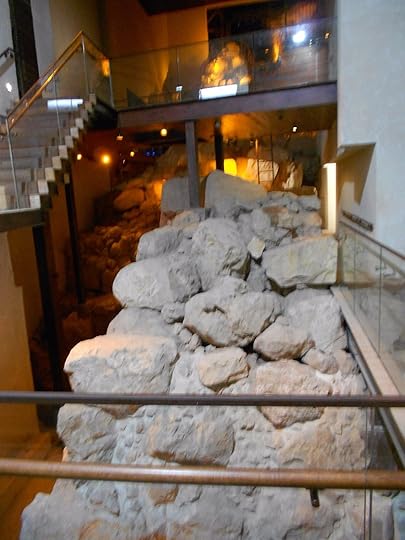 Here is one wall protecting the spring as it appears today. The wall extends to the second floor and beyond. It is wide and built of large stones. The group continued through Hezekiah’s Tunnel. Because Sarah was there last week but had not traveled through the Canaanite Tunnel, the three of us traveled that path. We saw the Canaanite wall (when Melchizedek was king) and other ruins. We walked down to Siloam Spring.
Here is one wall protecting the spring as it appears today. The wall extends to the second floor and beyond. It is wide and built of large stones. The group continued through Hezekiah’s Tunnel. Because Sarah was there last week but had not traveled through the Canaanite Tunnel, the three of us traveled that path. We saw the Canaanite wall (when Melchizedek was king) and other ruins. We walked down to Siloam Spring.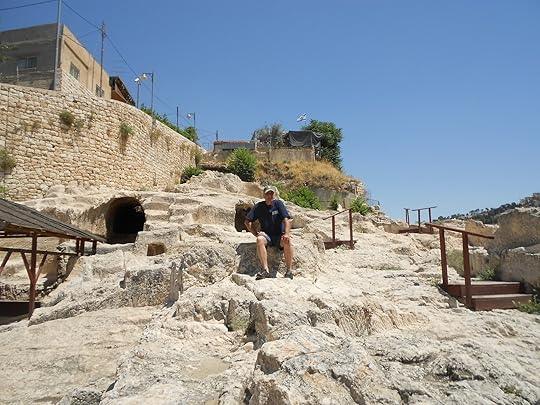 As we returned we saw an area the Romans used to quarry stone. They removed a lot of rock, so no archaeological work can be done. There appears to be two large tombs (behind me) on the hill. This could be the tomb of King David.
As we returned we saw an area the Romans used to quarry stone. They removed a lot of rock, so no archaeological work can be done. There appears to be two large tombs (behind me) on the hill. This could be the tomb of King David.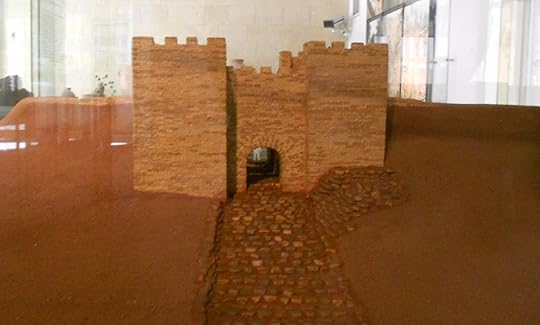 Following the tour we saw the Skirball Museum, Hebrew Union’s archeological museum. They have displays from Dan (where they are currently digging), Gezer (a past dig), and other sites. They have models of different gates at Dan, pictures from their digs, pottery, and other finds. We ate a Syrian hummus lunch with Dr. Ilan after seeing the Museum.
Following the tour we saw the Skirball Museum, Hebrew Union’s archeological museum. They have displays from Dan (where they are currently digging), Gezer (a past dig), and other sites. They have models of different gates at Dan, pictures from their digs, pottery, and other finds. We ate a Syrian hummus lunch with Dr. Ilan after seeing the Museum.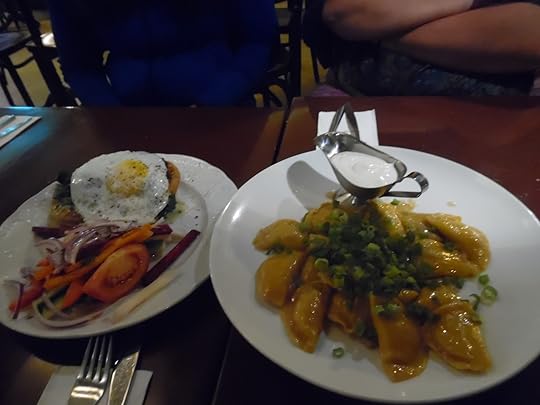
On the way home we visited the Jerusalem YMCA, a beautiful art deco building. We also saw a Herodian Tomb. We ate a dinner of Potato Kreplach and Spinach Tarte.
 In the picture above bedrock can be seen below the walls (above the grass). There are tombs chiseled into the soft chalk bedrock, showing that at one time this area was outside of the city. There are rocks above the tombs from the Roman Period (130-443 AD). Above those rocks, and slightly inside, are walls built by Sultan Suleiman the Magnificent (1535 AD).
In the picture above bedrock can be seen below the walls (above the grass). There are tombs chiseled into the soft chalk bedrock, showing that at one time this area was outside of the city. There are rocks above the tombs from the Roman Period (130-443 AD). Above those rocks, and slightly inside, are walls built by Sultan Suleiman the Magnificent (1535 AD). While we were standing by the wall, we looked across the Hinnom Valley. At the bottom of the valley is Sultan’s Pool, perhaps the Serpent Pool of Jesus’ time. This was part of the irrigation system for farms which lay below the city. Just above the pool is the old aqueduct which snakes around and into the city. Above that are homes built in 1860 - in a sense, Jerusalem’s first suburb.
While we were standing by the wall, we looked across the Hinnom Valley. At the bottom of the valley is Sultan’s Pool, perhaps the Serpent Pool of Jesus’ time. This was part of the irrigation system for farms which lay below the city. Just above the pool is the old aqueduct which snakes around and into the city. Above that are homes built in 1860 - in a sense, Jerusalem’s first suburb. We then walked south to the Zion Gate. This was on the Green Line in 1948 and several fierce battles were fought here. The walls are pocketed with the bullet holes from shelling and battle.
We then walked south to the Zion Gate. This was on the Green Line in 1948 and several fierce battles were fought here. The walls are pocketed with the bullet holes from shelling and battle. Continuing on the south wall, we passed a dig being done by UNCC (University of North Carolina Charlotte).
Continuing on the south wall, we passed a dig being done by UNCC (University of North Carolina Charlotte). Further along our walk we saw this dig. Dr. Ilan told us this was originally a parking area which was to be developed as a five story parking garage. Israeli law requires that an archeological survey must be done before anything new can be built in Israel. When the survey was done, ruins were discovered from the Turkish period, then by digging, the Roman, Greek, Hasmonean, and earlier. This is not surprising because this area is near the Tyropoeon Valley or Cheesemaker’s Valley, which runs through the center of the city. Four years into the dig, the garage was cancelled and the archeological find was placed along a walking path which leads to the Temple.
Further along our walk we saw this dig. Dr. Ilan told us this was originally a parking area which was to be developed as a five story parking garage. Israeli law requires that an archeological survey must be done before anything new can be built in Israel. When the survey was done, ruins were discovered from the Turkish period, then by digging, the Roman, Greek, Hasmonean, and earlier. This is not surprising because this area is near the Tyropoeon Valley or Cheesemaker’s Valley, which runs through the center of the city. Four years into the dig, the garage was cancelled and the archeological find was placed along a walking path which leads to the Temple. Further along the walls we saw more tombs cut into the bedrock. During the time of King David this area was inside the city, so the tombs must have come later. Jewish law forbids burial (except for kings) inside the city walls where people live. As the city walls move in and out and people necessarily come to live near the tombs, the Rabbis developed ways of ritually cleansing the tombs. Bones are removed and blessings are spoken so people can build on top of the tombs. That is what happened with these tombs, and they were refitted as cisterns with plaster on top, and houses above the plaster. The wall above the tombs is late period Ottoman.
Further along the walls we saw more tombs cut into the bedrock. During the time of King David this area was inside the city, so the tombs must have come later. Jewish law forbids burial (except for kings) inside the city walls where people live. As the city walls move in and out and people necessarily come to live near the tombs, the Rabbis developed ways of ritually cleansing the tombs. Bones are removed and blessings are spoken so people can build on top of the tombs. That is what happened with these tombs, and they were refitted as cisterns with plaster on top, and houses above the plaster. The wall above the tombs is late period Ottoman. Along the way we saw these concrete road barriers (like are being installed on I-77). I wonder why we can’t make them look this good in America?
Along the way we saw these concrete road barriers (like are being installed on I-77). I wonder why we can’t make them look this good in America? We came to the Old City of David (currently outside the walls of the city) where the Gihon spring is located. One objective of the day was to descend to the spring and see the ancient fortifications.We walked through the upper ruins, where the excavator thinks King David’s palace is located.
We came to the Old City of David (currently outside the walls of the city) where the Gihon spring is located. One objective of the day was to descend to the spring and see the ancient fortifications.We walked through the upper ruins, where the excavator thinks King David’s palace is located. This is Silwan, a neighborhood across the Kidron Valley from the City of David. In Biblical times Jerusalem looked much like this with the palace at the top (which is why David could look down and see Bathsheba on the rooftop).
This is Silwan, a neighborhood across the Kidron Valley from the City of David. In Biblical times Jerusalem looked much like this with the palace at the top (which is why David could look down and see Bathsheba on the rooftop).  Today the hillside looks like this, with remains of structures at the bottom. Some of the residents at the bottom of the hill are listed in the book of Jeremiah. The houses on this hillside go back to the time of King David, so people lived on this hillside for 500 years. Dr. Ilan talked about how difficult archeology and dating become when people can live in peace in an area for so long, without destruction levels to help date the civilization.
Today the hillside looks like this, with remains of structures at the bottom. Some of the residents at the bottom of the hill are listed in the book of Jeremiah. The houses on this hillside go back to the time of King David, so people lived on this hillside for 500 years. Dr. Ilan talked about how difficult archeology and dating become when people can live in peace in an area for so long, without destruction levels to help date the civilization. This blurred picture is what the city of David probably looked like. The Temple is at the top of the hill, the palace (Solomon’s) at the mid-section. The path to the Temple can be seen winding up the hill. The Gihon Spring can be seen just below the shine on the bottom left of the picture. This spring was fortified behind strong walls in order to protect the city’s water source. We walked down to Gihon Spring.
This blurred picture is what the city of David probably looked like. The Temple is at the top of the hill, the palace (Solomon’s) at the mid-section. The path to the Temple can be seen winding up the hill. The Gihon Spring can be seen just below the shine on the bottom left of the picture. This spring was fortified behind strong walls in order to protect the city’s water source. We walked down to Gihon Spring. Here is one wall protecting the spring as it appears today. The wall extends to the second floor and beyond. It is wide and built of large stones. The group continued through Hezekiah’s Tunnel. Because Sarah was there last week but had not traveled through the Canaanite Tunnel, the three of us traveled that path. We saw the Canaanite wall (when Melchizedek was king) and other ruins. We walked down to Siloam Spring.
Here is one wall protecting the spring as it appears today. The wall extends to the second floor and beyond. It is wide and built of large stones. The group continued through Hezekiah’s Tunnel. Because Sarah was there last week but had not traveled through the Canaanite Tunnel, the three of us traveled that path. We saw the Canaanite wall (when Melchizedek was king) and other ruins. We walked down to Siloam Spring. As we returned we saw an area the Romans used to quarry stone. They removed a lot of rock, so no archaeological work can be done. There appears to be two large tombs (behind me) on the hill. This could be the tomb of King David.
As we returned we saw an area the Romans used to quarry stone. They removed a lot of rock, so no archaeological work can be done. There appears to be two large tombs (behind me) on the hill. This could be the tomb of King David. Following the tour we saw the Skirball Museum, Hebrew Union’s archeological museum. They have displays from Dan (where they are currently digging), Gezer (a past dig), and other sites. They have models of different gates at Dan, pictures from their digs, pottery, and other finds. We ate a Syrian hummus lunch with Dr. Ilan after seeing the Museum.
Following the tour we saw the Skirball Museum, Hebrew Union’s archeological museum. They have displays from Dan (where they are currently digging), Gezer (a past dig), and other sites. They have models of different gates at Dan, pictures from their digs, pottery, and other finds. We ate a Syrian hummus lunch with Dr. Ilan after seeing the Museum.
On the way home we visited the Jerusalem YMCA, a beautiful art deco building. We also saw a Herodian Tomb. We ate a dinner of Potato Kreplach and Spinach Tarte.
Published on June 20, 2016 12:02
June 19, 2016
Israel Adventure - Day 10
Today we began Chelsea’s Summer program with Hebrew Union in Jerusalem. They invited families to come, so Sarah and I are welcome also as long as we are in Jerusalem. (The time here is drawing to an end much too fast.) The program was informative and took us places we have not visited before.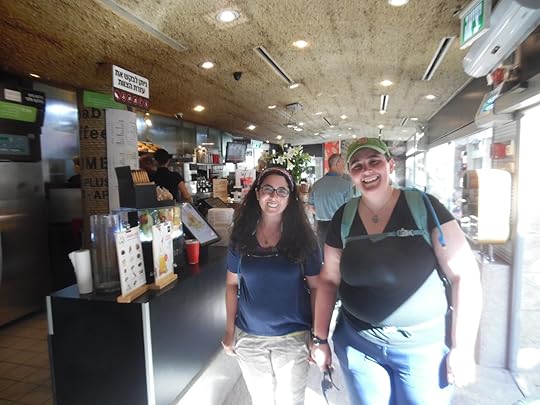 We started the day with breakfast (wouldn’t miss!) at Aroma Coffee. We walked to the closest shop, which is only about 5 minutes from the school at a place called the Mamilla Mall. After breakfast we walked to the school.
We started the day with breakfast (wouldn’t miss!) at Aroma Coffee. We walked to the closest shop, which is only about 5 minutes from the school at a place called the Mamilla Mall. After breakfast we walked to the school.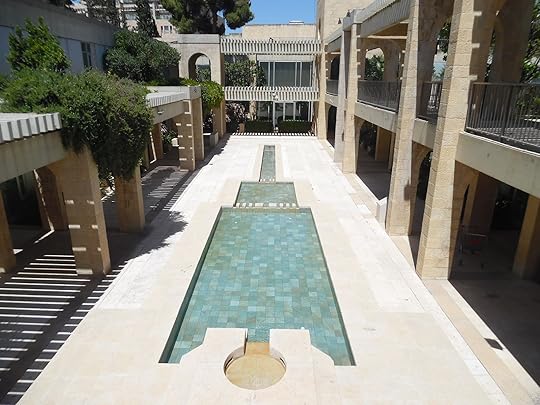 We then walked to Hebrew Union where we were met by Dr. Calmann (professor from Cincinnati) and Dr. David Ilan, head of the school of Archaeology in Jerusalem. I was quite impressed by him.
We then walked to Hebrew Union where we were met by Dr. Calmann (professor from Cincinnati) and Dr. David Ilan, head of the school of Archaeology in Jerusalem. I was quite impressed by him.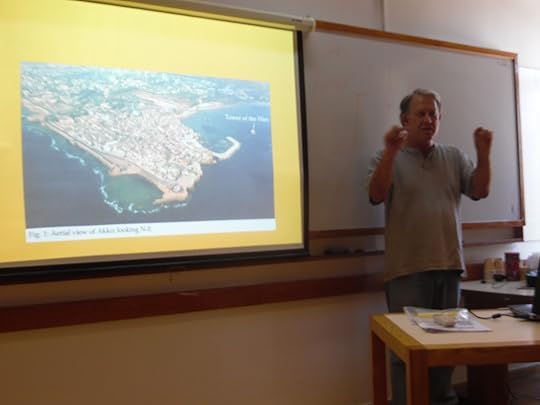 Dr. Ilan began our time together with introductions, followed by a lecture on the geography of Israel. He looked at trade routes, climate zones, and currents in the Mediterranean Sea. We dissected the country in zones West to East and then North to South. He carefully explained each zone. He showed us how where the sand came from, what the word shephlah means, and why it is important, the importance of the watershed and the Patriarch highway, the rift valley, and the Jordanian highlands.
Dr. Ilan began our time together with introductions, followed by a lecture on the geography of Israel. He looked at trade routes, climate zones, and currents in the Mediterranean Sea. We dissected the country in zones West to East and then North to South. He carefully explained each zone. He showed us how where the sand came from, what the word shephlah means, and why it is important, the importance of the watershed and the Patriarch highway, the rift valley, and the Jordanian highlands.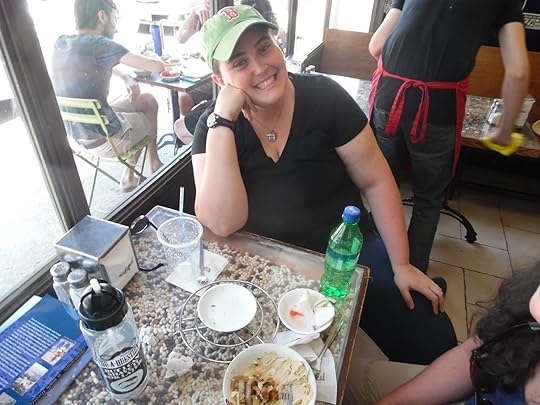 We took a break for looking around Hebrew Union on our own, or to get snacks, then for lunch at noon. Chelsea, Sarah and I ate at Ben Sirach’s near Ben Yeudah Street. We had hummus and pita. The lunch was great!
We took a break for looking around Hebrew Union on our own, or to get snacks, then for lunch at noon. Chelsea, Sarah and I ate at Ben Sirach’s near Ben Yeudah Street. We had hummus and pita. The lunch was great!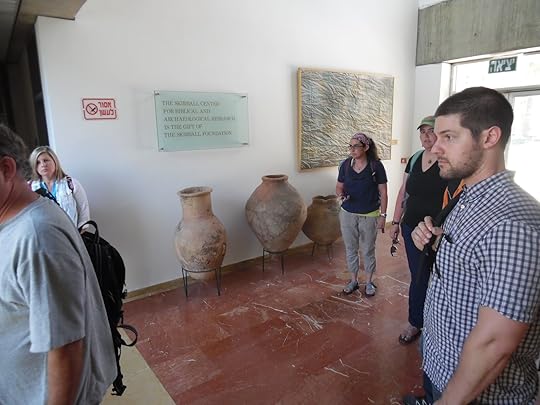 We then went back to the school, meeting at David Ilan’s office to set off on our adventures.
We then went back to the school, meeting at David Ilan’s office to set off on our adventures.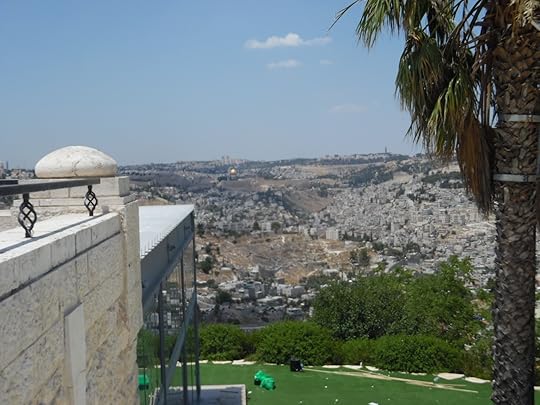 We went to the Haas Promenade, an overlook to the south of Jerusalem, where we could see everything. Dr. Ilan pointed out the old city, East Jerusalem and West Jerusalem. He showed us major points in the city, and he also showed us the older part and newer part. He pointed out the hill which the city rests on, its water source, and defensibility. We saw where the Palestinians live, and Jewish communities. He shared information about plants and birds in the area.
We went to the Haas Promenade, an overlook to the south of Jerusalem, where we could see everything. Dr. Ilan pointed out the old city, East Jerusalem and West Jerusalem. He showed us major points in the city, and he also showed us the older part and newer part. He pointed out the hill which the city rests on, its water source, and defensibility. We saw where the Palestinians live, and Jewish communities. He shared information about plants and birds in the area.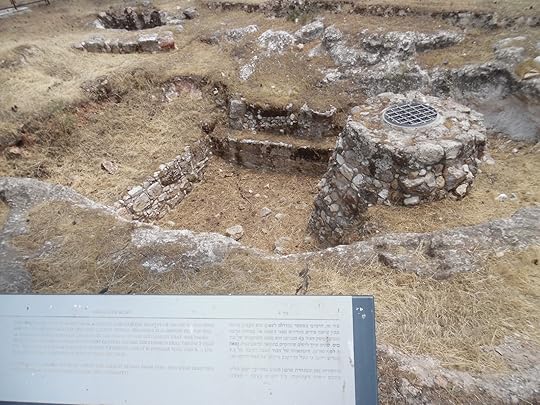 We walked along the hill to the place where we could see the old Roman Aqueduct, which provided water through the time of the Ottoman Empire. He shared about gravity and syphon style aqueducts.We also saw Jordan from this height.
We walked along the hill to the place where we could see the old Roman Aqueduct, which provided water through the time of the Ottoman Empire. He shared about gravity and syphon style aqueducts.We also saw Jordan from this height.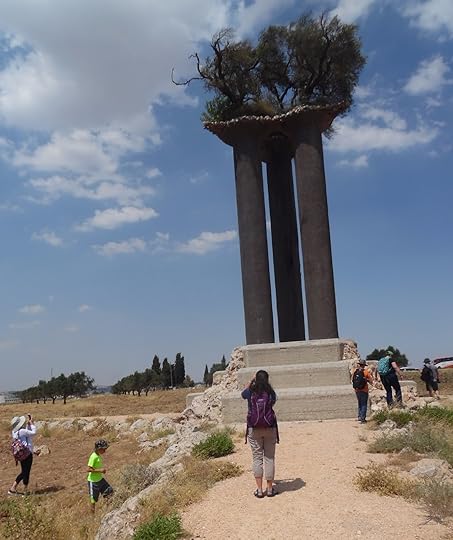 After the Promenade we traveled to a memorial along the old border with Jordan. This is a piece of artwork by Ran Morin called Olive Columns. There are three live olive trees on the pillars (possibly for the desire for peace between the three world religions) The monument was huge.From the site we could see the wall along the West Bank, bunkers, and communities of Jews and Palestinians. We saw Herodian and Bethlehem. We could also see the Dead Sea and Jordan.
After the Promenade we traveled to a memorial along the old border with Jordan. This is a piece of artwork by Ran Morin called Olive Columns. There are three live olive trees on the pillars (possibly for the desire for peace between the three world religions) The monument was huge.From the site we could see the wall along the West Bank, bunkers, and communities of Jews and Palestinians. We saw Herodian and Bethlehem. We could also see the Dead Sea and Jordan.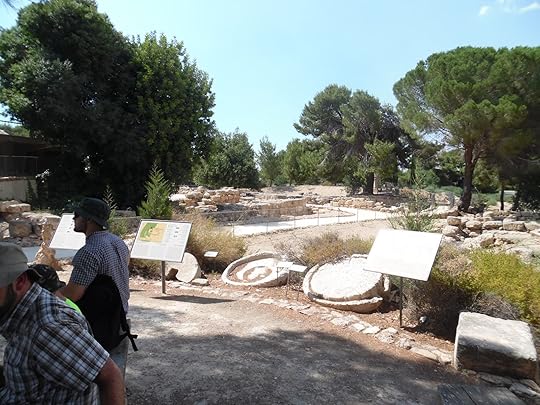 We continued on the ridge to Ramat Rachel, an ancient archeological site on the main road between Jerusalem and Bethlehem. The vantage point of this location is outstanding, which made it a fortress in the 6th Century BC, when the Assyrians were attacking Jerusalem. Many seals have been found bearing King Hezekiah’s mark at this location.
We continued on the ridge to Ramat Rachel, an ancient archeological site on the main road between Jerusalem and Bethlehem. The vantage point of this location is outstanding, which made it a fortress in the 6th Century BC, when the Assyrians were attacking Jerusalem. Many seals have been found bearing King Hezekiah’s mark at this location. 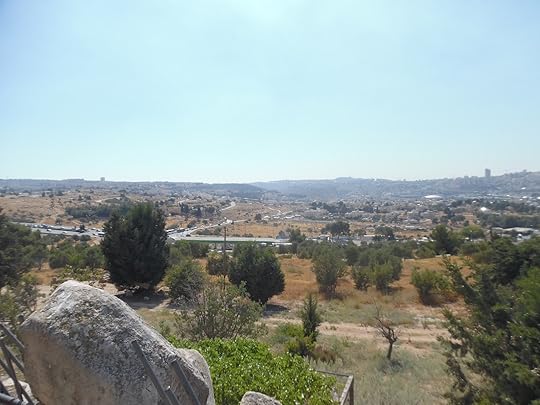 The site began as a watchtower on the high hill which could easily observe the central ridge road between Jerusalem and Bethlehem. Then a palace was built at the site with a large courtyard. The building was made of finely cut stones and contained royal columns. The Assyrians, who controlled the site for a time built a hanging garden in the palace. The site went through various transitions through the Babylonian, Hasmonean, Roman and Byzantine periods. In the Roman period there was a large home there which was part of a farming estate. Later there was a church built on the site.
The site began as a watchtower on the high hill which could easily observe the central ridge road between Jerusalem and Bethlehem. Then a palace was built at the site with a large courtyard. The building was made of finely cut stones and contained royal columns. The Assyrians, who controlled the site for a time built a hanging garden in the palace. The site went through various transitions through the Babylonian, Hasmonean, Roman and Byzantine periods. In the Roman period there was a large home there which was part of a farming estate. Later there was a church built on the site. 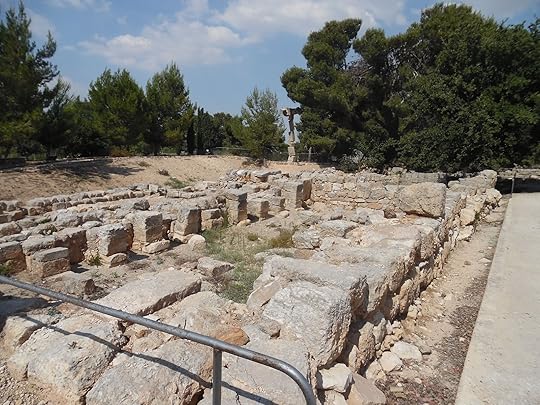 We looked at building styles, cisterns, pottery, and other artifacts left at the site.With that the program was finished, and it was time to go home. We went into an exclusive kibbutz hotel next to the site to get a coke, and decided to call Shlomo, who was our guide on previous trips to Israel to see if he was available for dinner. He was, in fact his wife had a meeting at the kibbutz an hour after we had called. He and his wife met us, and we drove to Jerusalem’ s First Train Station, and at dinner at the same restaurant we had eaten breakfast at the day before.
We looked at building styles, cisterns, pottery, and other artifacts left at the site.With that the program was finished, and it was time to go home. We went into an exclusive kibbutz hotel next to the site to get a coke, and decided to call Shlomo, who was our guide on previous trips to Israel to see if he was available for dinner. He was, in fact his wife had a meeting at the kibbutz an hour after we had called. He and his wife met us, and we drove to Jerusalem’ s First Train Station, and at dinner at the same restaurant we had eaten breakfast at the day before.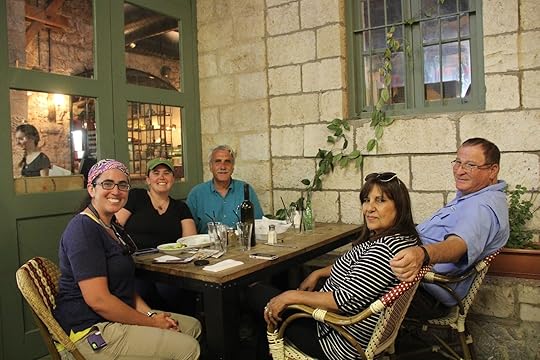 We talked about family, friends, and our trips. We also began talking about a trip to Israel in 2018, probably in June. The trip would include an option to participate in an archeological dig, and then a tour of Israel. Please let me know if you are interested, and I will put you on a mailing list (no obligation). Cost would be about $5,000 per person. If you would like to go, please begin to set aside money for the trip, and let me know. Also, because we are in the planning stage, if you would like to see something specific, let me know, so it can be included in plans.
We talked about family, friends, and our trips. We also began talking about a trip to Israel in 2018, probably in June. The trip would include an option to participate in an archeological dig, and then a tour of Israel. Please let me know if you are interested, and I will put you on a mailing list (no obligation). Cost would be about $5,000 per person. If you would like to go, please begin to set aside money for the trip, and let me know. Also, because we are in the planning stage, if you would like to see something specific, let me know, so it can be included in plans.
 We started the day with breakfast (wouldn’t miss!) at Aroma Coffee. We walked to the closest shop, which is only about 5 minutes from the school at a place called the Mamilla Mall. After breakfast we walked to the school.
We started the day with breakfast (wouldn’t miss!) at Aroma Coffee. We walked to the closest shop, which is only about 5 minutes from the school at a place called the Mamilla Mall. After breakfast we walked to the school. We then walked to Hebrew Union where we were met by Dr. Calmann (professor from Cincinnati) and Dr. David Ilan, head of the school of Archaeology in Jerusalem. I was quite impressed by him.
We then walked to Hebrew Union where we were met by Dr. Calmann (professor from Cincinnati) and Dr. David Ilan, head of the school of Archaeology in Jerusalem. I was quite impressed by him. Dr. Ilan began our time together with introductions, followed by a lecture on the geography of Israel. He looked at trade routes, climate zones, and currents in the Mediterranean Sea. We dissected the country in zones West to East and then North to South. He carefully explained each zone. He showed us how where the sand came from, what the word shephlah means, and why it is important, the importance of the watershed and the Patriarch highway, the rift valley, and the Jordanian highlands.
Dr. Ilan began our time together with introductions, followed by a lecture on the geography of Israel. He looked at trade routes, climate zones, and currents in the Mediterranean Sea. We dissected the country in zones West to East and then North to South. He carefully explained each zone. He showed us how where the sand came from, what the word shephlah means, and why it is important, the importance of the watershed and the Patriarch highway, the rift valley, and the Jordanian highlands. We took a break for looking around Hebrew Union on our own, or to get snacks, then for lunch at noon. Chelsea, Sarah and I ate at Ben Sirach’s near Ben Yeudah Street. We had hummus and pita. The lunch was great!
We took a break for looking around Hebrew Union on our own, or to get snacks, then for lunch at noon. Chelsea, Sarah and I ate at Ben Sirach’s near Ben Yeudah Street. We had hummus and pita. The lunch was great! We then went back to the school, meeting at David Ilan’s office to set off on our adventures.
We then went back to the school, meeting at David Ilan’s office to set off on our adventures. We went to the Haas Promenade, an overlook to the south of Jerusalem, where we could see everything. Dr. Ilan pointed out the old city, East Jerusalem and West Jerusalem. He showed us major points in the city, and he also showed us the older part and newer part. He pointed out the hill which the city rests on, its water source, and defensibility. We saw where the Palestinians live, and Jewish communities. He shared information about plants and birds in the area.
We went to the Haas Promenade, an overlook to the south of Jerusalem, where we could see everything. Dr. Ilan pointed out the old city, East Jerusalem and West Jerusalem. He showed us major points in the city, and he also showed us the older part and newer part. He pointed out the hill which the city rests on, its water source, and defensibility. We saw where the Palestinians live, and Jewish communities. He shared information about plants and birds in the area. We walked along the hill to the place where we could see the old Roman Aqueduct, which provided water through the time of the Ottoman Empire. He shared about gravity and syphon style aqueducts.We also saw Jordan from this height.
We walked along the hill to the place where we could see the old Roman Aqueduct, which provided water through the time of the Ottoman Empire. He shared about gravity and syphon style aqueducts.We also saw Jordan from this height. After the Promenade we traveled to a memorial along the old border with Jordan. This is a piece of artwork by Ran Morin called Olive Columns. There are three live olive trees on the pillars (possibly for the desire for peace between the three world religions) The monument was huge.From the site we could see the wall along the West Bank, bunkers, and communities of Jews and Palestinians. We saw Herodian and Bethlehem. We could also see the Dead Sea and Jordan.
After the Promenade we traveled to a memorial along the old border with Jordan. This is a piece of artwork by Ran Morin called Olive Columns. There are three live olive trees on the pillars (possibly for the desire for peace between the three world religions) The monument was huge.From the site we could see the wall along the West Bank, bunkers, and communities of Jews and Palestinians. We saw Herodian and Bethlehem. We could also see the Dead Sea and Jordan. We continued on the ridge to Ramat Rachel, an ancient archeological site on the main road between Jerusalem and Bethlehem. The vantage point of this location is outstanding, which made it a fortress in the 6th Century BC, when the Assyrians were attacking Jerusalem. Many seals have been found bearing King Hezekiah’s mark at this location.
We continued on the ridge to Ramat Rachel, an ancient archeological site on the main road between Jerusalem and Bethlehem. The vantage point of this location is outstanding, which made it a fortress in the 6th Century BC, when the Assyrians were attacking Jerusalem. Many seals have been found bearing King Hezekiah’s mark at this location.  The site began as a watchtower on the high hill which could easily observe the central ridge road between Jerusalem and Bethlehem. Then a palace was built at the site with a large courtyard. The building was made of finely cut stones and contained royal columns. The Assyrians, who controlled the site for a time built a hanging garden in the palace. The site went through various transitions through the Babylonian, Hasmonean, Roman and Byzantine periods. In the Roman period there was a large home there which was part of a farming estate. Later there was a church built on the site.
The site began as a watchtower on the high hill which could easily observe the central ridge road between Jerusalem and Bethlehem. Then a palace was built at the site with a large courtyard. The building was made of finely cut stones and contained royal columns. The Assyrians, who controlled the site for a time built a hanging garden in the palace. The site went through various transitions through the Babylonian, Hasmonean, Roman and Byzantine periods. In the Roman period there was a large home there which was part of a farming estate. Later there was a church built on the site.  We looked at building styles, cisterns, pottery, and other artifacts left at the site.With that the program was finished, and it was time to go home. We went into an exclusive kibbutz hotel next to the site to get a coke, and decided to call Shlomo, who was our guide on previous trips to Israel to see if he was available for dinner. He was, in fact his wife had a meeting at the kibbutz an hour after we had called. He and his wife met us, and we drove to Jerusalem’ s First Train Station, and at dinner at the same restaurant we had eaten breakfast at the day before.
We looked at building styles, cisterns, pottery, and other artifacts left at the site.With that the program was finished, and it was time to go home. We went into an exclusive kibbutz hotel next to the site to get a coke, and decided to call Shlomo, who was our guide on previous trips to Israel to see if he was available for dinner. He was, in fact his wife had a meeting at the kibbutz an hour after we had called. He and his wife met us, and we drove to Jerusalem’ s First Train Station, and at dinner at the same restaurant we had eaten breakfast at the day before. We talked about family, friends, and our trips. We also began talking about a trip to Israel in 2018, probably in June. The trip would include an option to participate in an archeological dig, and then a tour of Israel. Please let me know if you are interested, and I will put you on a mailing list (no obligation). Cost would be about $5,000 per person. If you would like to go, please begin to set aside money for the trip, and let me know. Also, because we are in the planning stage, if you would like to see something specific, let me know, so it can be included in plans.
We talked about family, friends, and our trips. We also began talking about a trip to Israel in 2018, probably in June. The trip would include an option to participate in an archeological dig, and then a tour of Israel. Please let me know if you are interested, and I will put you on a mailing list (no obligation). Cost would be about $5,000 per person. If you would like to go, please begin to set aside money for the trip, and let me know. Also, because we are in the planning stage, if you would like to see something specific, let me know, so it can be included in plans.
Published on June 19, 2016 20:39
June 18, 2016
Israel Adventure - Day 9
This is Shabbat, and in Jerusalem most people observe Shabbat. The streets are quiet, and most businesses are closed. We began the day by finding a restaurant in Jerusalem's First Train Station, a modern center with shops, amusements, and many special events such as the National Book Week taking place this week and the film festival we enjoyed there two years ago. Of course the book fair was closed for Shabbat, but two restaurants were open for breakfast. We had Mediterranean shakshuka with eggplant and feta and nutella rozalach.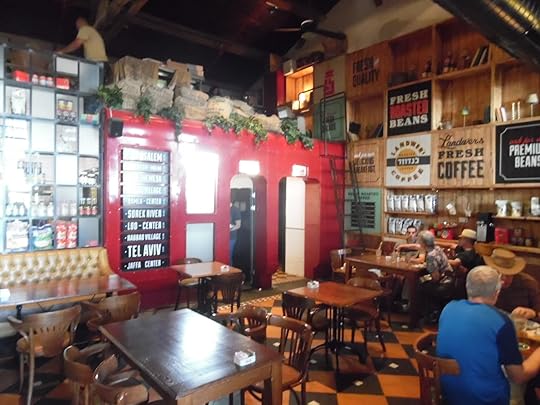 The restaurant was interesting - a railroad car served as part of the decor. Restrooms were located inside the train, and storage was above. Chelsea asked why I didn’t design her bedroom like that with her bed on the top level.
The restaurant was interesting - a railroad car served as part of the decor. Restrooms were located inside the train, and storage was above. Chelsea asked why I didn’t design her bedroom like that with her bed on the top level.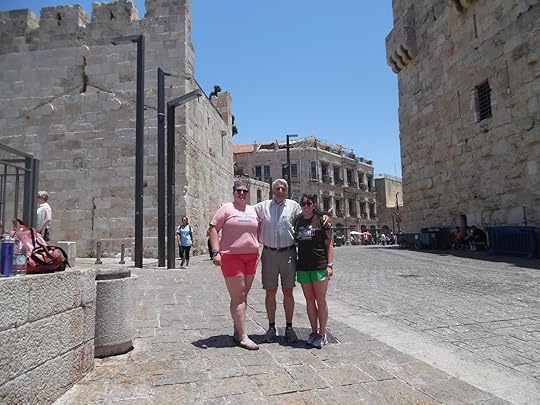 Following breakfast we walked to the Old City and entered through the Jaffa Gate. We met a couple of tourists from London, England who took our picture.
Following breakfast we walked to the Old City and entered through the Jaffa Gate. We met a couple of tourists from London, England who took our picture.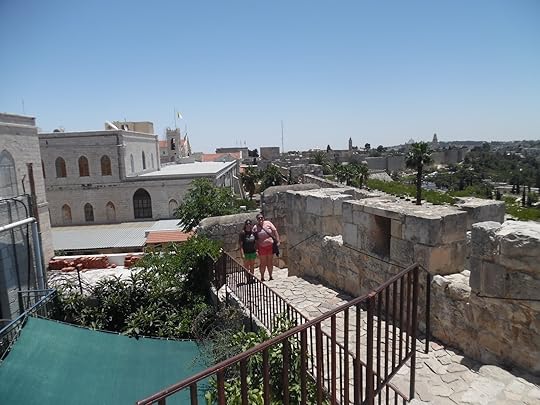 Upon entry we went up on the ramparts, or walls around the city. We went north and then east, from the Jaffa Gate, over the New Gate, past the Damascus Gate, beyond the Herod Gate, and to the Lion’s gate.
Upon entry we went up on the ramparts, or walls around the city. We went north and then east, from the Jaffa Gate, over the New Gate, past the Damascus Gate, beyond the Herod Gate, and to the Lion’s gate.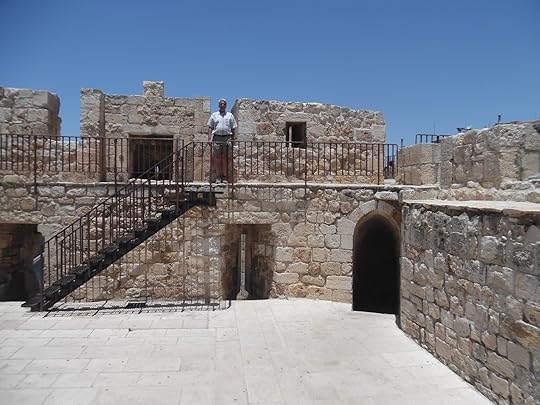 Of course the walls have a military purpose, so several areas are built like fortresses. This one is at the Jaffa Gate. It is a well-fortified tower which provides visibility in over a 180-degree range. The towers can be several levels high.
Of course the walls have a military purpose, so several areas are built like fortresses. This one is at the Jaffa Gate. It is a well-fortified tower which provides visibility in over a 180-degree range. The towers can be several levels high.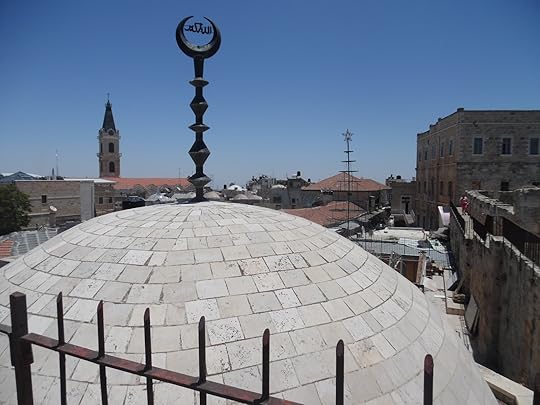 The walk along the walls provides many great rooftop views, including this view of a family Mosque built on a later (but destroyed) tower along the walls. (The walls are 500 years old.) Across the roof of the Mosque you can see Jerusalem is a city of many faiths: Islamic, Christian, and Jewish. The steeple above is (I think) the Lutheran Church and a Christmas star also adorns the skyline to the right of the Mosque.
The walk along the walls provides many great rooftop views, including this view of a family Mosque built on a later (but destroyed) tower along the walls. (The walls are 500 years old.) Across the roof of the Mosque you can see Jerusalem is a city of many faiths: Islamic, Christian, and Jewish. The steeple above is (I think) the Lutheran Church and a Christmas star also adorns the skyline to the right of the Mosque.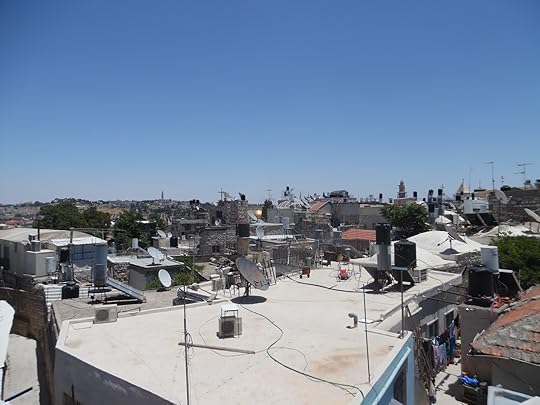 Along the tour, the Dome of the Rock was visible at several points.
Along the tour, the Dome of the Rock was visible at several points. 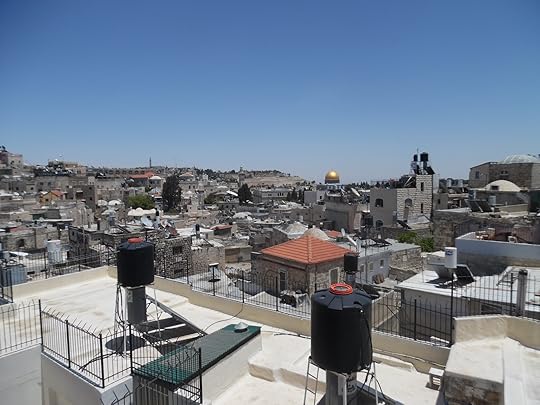 The Mount of Olives is also visible in the background in this picture.
The Mount of Olives is also visible in the background in this picture.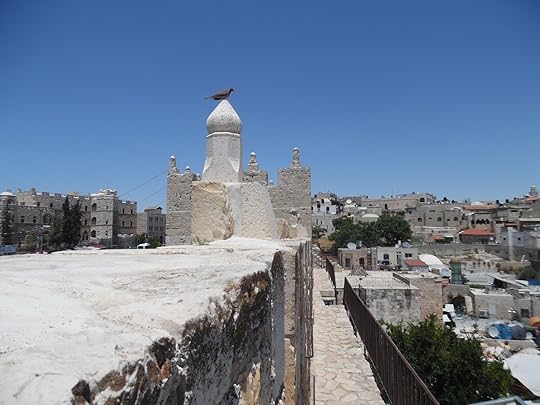 Along the wall we saw doves, sparrows, lizards, cats, and other interesting sights. The day was quite warm by the time we were walking the wall. There were a few areas of shade, but mostly sunshine.
Along the wall we saw doves, sparrows, lizards, cats, and other interesting sights. The day was quite warm by the time we were walking the wall. There were a few areas of shade, but mostly sunshine.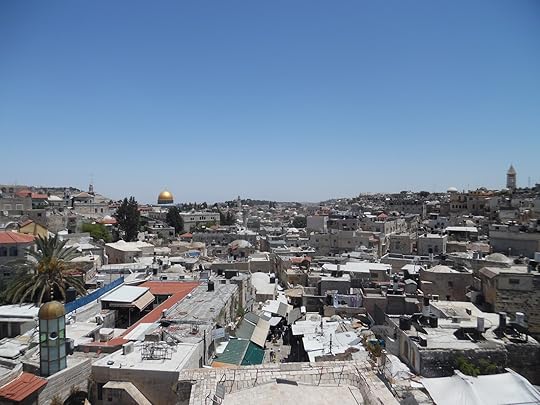 We walked up and down along the wall with the lay of the land of the hills of Jerusalem.
We walked up and down along the wall with the lay of the land of the hills of Jerusalem.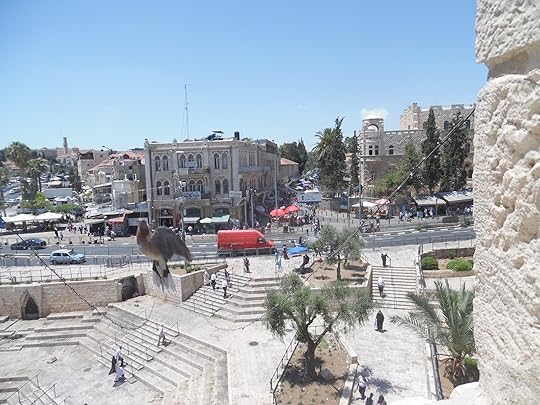 We could see both into the walled city and to the outside city of Jerusalem. Here is the view of the Damascus Gate, headed north. This gate is the main gate to the Moslem Quarter of the city. We entered through this gate many times when we came to Jerusalem four years ago. Our motel was about five blocks north of the gate.
We could see both into the walled city and to the outside city of Jerusalem. Here is the view of the Damascus Gate, headed north. This gate is the main gate to the Moslem Quarter of the city. We entered through this gate many times when we came to Jerusalem four years ago. Our motel was about five blocks north of the gate.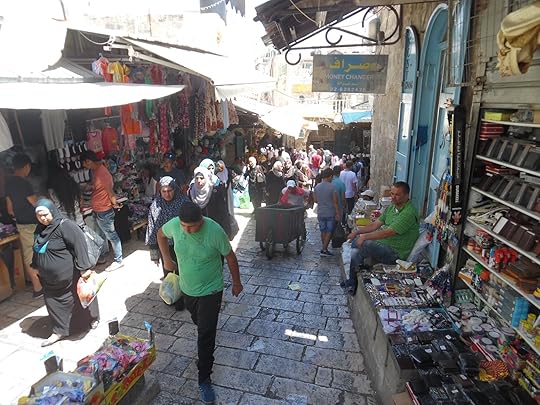 Following our walk on the wall (which took almost two hours) we exited at the Damascus Gate and walked through the market to get a Coke. We looked at the shops around us, then went on our next adventure. Earlier this year when I was researching early Christian worship with Sarah for one of her classes, I spotted that the oldest church in the world is St. Mark’s Syrian Orthodox Church in the old city.
Following our walk on the wall (which took almost two hours) we exited at the Damascus Gate and walked through the market to get a Coke. We looked at the shops around us, then went on our next adventure. Earlier this year when I was researching early Christian worship with Sarah for one of her classes, I spotted that the oldest church in the world is St. Mark’s Syrian Orthodox Church in the old city. 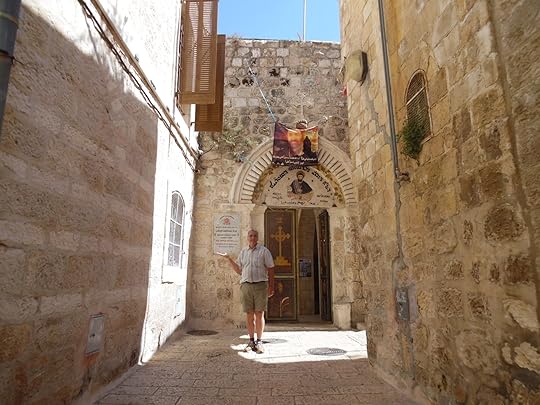 After finding our way there (the church is on a back street), we entered the outside patio, only to find the church itself closed. We sat in the shade a minute, then a German woman came downstairs to see why we were there. She called her son who spoke English to talk to us, and he told us that the woman who gives tours was taking her nap and to come back in two hours. We were about to walk out when she came downstairs and took us inside the church.She told the history of the church and its site which goes back to the Last Supper in the Upper Room. (Mark invited Jesus to dine at his home for Passover.) This was also the place where the disciples went after Jesus died and when the Holy Spirit came upon them. She showed us the altar, which was beautiful. There is a painting of Mary and Jesus traditionally created by Dr. Luke (of the Bible). It is painted on leather and the faces show up when a candle is placed in front of the picture. Mary is holding Jesus as a baby, but his face is painted as an adult.
After finding our way there (the church is on a back street), we entered the outside patio, only to find the church itself closed. We sat in the shade a minute, then a German woman came downstairs to see why we were there. She called her son who spoke English to talk to us, and he told us that the woman who gives tours was taking her nap and to come back in two hours. We were about to walk out when she came downstairs and took us inside the church.She told the history of the church and its site which goes back to the Last Supper in the Upper Room. (Mark invited Jesus to dine at his home for Passover.) This was also the place where the disciples went after Jesus died and when the Holy Spirit came upon them. She showed us the altar, which was beautiful. There is a painting of Mary and Jesus traditionally created by Dr. Luke (of the Bible). It is painted on leather and the faces show up when a candle is placed in front of the picture. Mary is holding Jesus as a baby, but his face is painted as an adult.
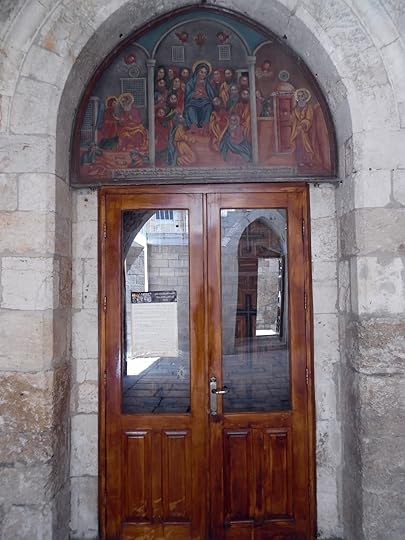 She explained the Upper Room is now downstairs - because as cities grow older and go through the cycle of destruction and rebuilding, they grow upwards. We went down the stairs to a well kept stone room, which definitely does not date to the period. The building in which the church is meeting is fairly new, only about 800 years old. There is a history (on the link) which tells how during restoration of St. Marks an inscription was found from the sixth century which says, “This is the house of Mary, mother of John, called Mark. Proclaimed a church by the holy apostles under the name of Virgin Mary, mother of God, after the ascension of our Lord Jesus Christ into heaven. Renewed after the destruction of Jerusalem by Titus in the year AD 73.” Pilgrims visited this site as early as 333 AD.
She explained the Upper Room is now downstairs - because as cities grow older and go through the cycle of destruction and rebuilding, they grow upwards. We went down the stairs to a well kept stone room, which definitely does not date to the period. The building in which the church is meeting is fairly new, only about 800 years old. There is a history (on the link) which tells how during restoration of St. Marks an inscription was found from the sixth century which says, “This is the house of Mary, mother of John, called Mark. Proclaimed a church by the holy apostles under the name of Virgin Mary, mother of God, after the ascension of our Lord Jesus Christ into heaven. Renewed after the destruction of Jerusalem by Titus in the year AD 73.” Pilgrims visited this site as early as 333 AD.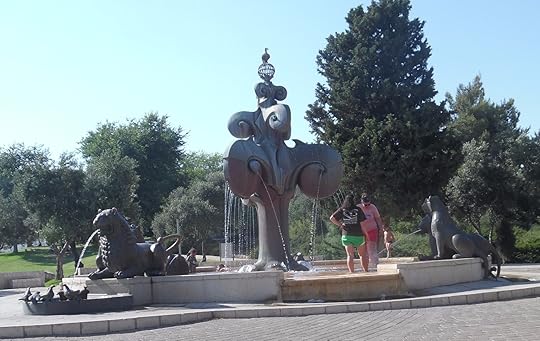 After our visit to the church we headed home. But before we arrived we stopped at the lion fountain and Chelsea and Sarah dipped their feet in to cool off. Then we returned home for a rest.
After our visit to the church we headed home. But before we arrived we stopped at the lion fountain and Chelsea and Sarah dipped their feet in to cool off. Then we returned home for a rest.
At dinner time we ate hummus at Jerusalem’s First Train Station again and shopped at the book sale. Most of the books were in Hebrew, and some were familiar because we knew the cover. (Dr. Seuss collections, Disney Collections, and others). We also saw a few books in English. We enjoyed practicing reading some Hebrew and looking through the books.
 The restaurant was interesting - a railroad car served as part of the decor. Restrooms were located inside the train, and storage was above. Chelsea asked why I didn’t design her bedroom like that with her bed on the top level.
The restaurant was interesting - a railroad car served as part of the decor. Restrooms were located inside the train, and storage was above. Chelsea asked why I didn’t design her bedroom like that with her bed on the top level. Following breakfast we walked to the Old City and entered through the Jaffa Gate. We met a couple of tourists from London, England who took our picture.
Following breakfast we walked to the Old City and entered through the Jaffa Gate. We met a couple of tourists from London, England who took our picture. Upon entry we went up on the ramparts, or walls around the city. We went north and then east, from the Jaffa Gate, over the New Gate, past the Damascus Gate, beyond the Herod Gate, and to the Lion’s gate.
Upon entry we went up on the ramparts, or walls around the city. We went north and then east, from the Jaffa Gate, over the New Gate, past the Damascus Gate, beyond the Herod Gate, and to the Lion’s gate. Of course the walls have a military purpose, so several areas are built like fortresses. This one is at the Jaffa Gate. It is a well-fortified tower which provides visibility in over a 180-degree range. The towers can be several levels high.
Of course the walls have a military purpose, so several areas are built like fortresses. This one is at the Jaffa Gate. It is a well-fortified tower which provides visibility in over a 180-degree range. The towers can be several levels high. The walk along the walls provides many great rooftop views, including this view of a family Mosque built on a later (but destroyed) tower along the walls. (The walls are 500 years old.) Across the roof of the Mosque you can see Jerusalem is a city of many faiths: Islamic, Christian, and Jewish. The steeple above is (I think) the Lutheran Church and a Christmas star also adorns the skyline to the right of the Mosque.
The walk along the walls provides many great rooftop views, including this view of a family Mosque built on a later (but destroyed) tower along the walls. (The walls are 500 years old.) Across the roof of the Mosque you can see Jerusalem is a city of many faiths: Islamic, Christian, and Jewish. The steeple above is (I think) the Lutheran Church and a Christmas star also adorns the skyline to the right of the Mosque. Along the tour, the Dome of the Rock was visible at several points.
Along the tour, the Dome of the Rock was visible at several points.  The Mount of Olives is also visible in the background in this picture.
The Mount of Olives is also visible in the background in this picture. Along the wall we saw doves, sparrows, lizards, cats, and other interesting sights. The day was quite warm by the time we were walking the wall. There were a few areas of shade, but mostly sunshine.
Along the wall we saw doves, sparrows, lizards, cats, and other interesting sights. The day was quite warm by the time we were walking the wall. There were a few areas of shade, but mostly sunshine. We walked up and down along the wall with the lay of the land of the hills of Jerusalem.
We walked up and down along the wall with the lay of the land of the hills of Jerusalem. We could see both into the walled city and to the outside city of Jerusalem. Here is the view of the Damascus Gate, headed north. This gate is the main gate to the Moslem Quarter of the city. We entered through this gate many times when we came to Jerusalem four years ago. Our motel was about five blocks north of the gate.
We could see both into the walled city and to the outside city of Jerusalem. Here is the view of the Damascus Gate, headed north. This gate is the main gate to the Moslem Quarter of the city. We entered through this gate many times when we came to Jerusalem four years ago. Our motel was about five blocks north of the gate. Following our walk on the wall (which took almost two hours) we exited at the Damascus Gate and walked through the market to get a Coke. We looked at the shops around us, then went on our next adventure. Earlier this year when I was researching early Christian worship with Sarah for one of her classes, I spotted that the oldest church in the world is St. Mark’s Syrian Orthodox Church in the old city.
Following our walk on the wall (which took almost two hours) we exited at the Damascus Gate and walked through the market to get a Coke. We looked at the shops around us, then went on our next adventure. Earlier this year when I was researching early Christian worship with Sarah for one of her classes, I spotted that the oldest church in the world is St. Mark’s Syrian Orthodox Church in the old city.  After finding our way there (the church is on a back street), we entered the outside patio, only to find the church itself closed. We sat in the shade a minute, then a German woman came downstairs to see why we were there. She called her son who spoke English to talk to us, and he told us that the woman who gives tours was taking her nap and to come back in two hours. We were about to walk out when she came downstairs and took us inside the church.She told the history of the church and its site which goes back to the Last Supper in the Upper Room. (Mark invited Jesus to dine at his home for Passover.) This was also the place where the disciples went after Jesus died and when the Holy Spirit came upon them. She showed us the altar, which was beautiful. There is a painting of Mary and Jesus traditionally created by Dr. Luke (of the Bible). It is painted on leather and the faces show up when a candle is placed in front of the picture. Mary is holding Jesus as a baby, but his face is painted as an adult.
After finding our way there (the church is on a back street), we entered the outside patio, only to find the church itself closed. We sat in the shade a minute, then a German woman came downstairs to see why we were there. She called her son who spoke English to talk to us, and he told us that the woman who gives tours was taking her nap and to come back in two hours. We were about to walk out when she came downstairs and took us inside the church.She told the history of the church and its site which goes back to the Last Supper in the Upper Room. (Mark invited Jesus to dine at his home for Passover.) This was also the place where the disciples went after Jesus died and when the Holy Spirit came upon them. She showed us the altar, which was beautiful. There is a painting of Mary and Jesus traditionally created by Dr. Luke (of the Bible). It is painted on leather and the faces show up when a candle is placed in front of the picture. Mary is holding Jesus as a baby, but his face is painted as an adult.
 She explained the Upper Room is now downstairs - because as cities grow older and go through the cycle of destruction and rebuilding, they grow upwards. We went down the stairs to a well kept stone room, which definitely does not date to the period. The building in which the church is meeting is fairly new, only about 800 years old. There is a history (on the link) which tells how during restoration of St. Marks an inscription was found from the sixth century which says, “This is the house of Mary, mother of John, called Mark. Proclaimed a church by the holy apostles under the name of Virgin Mary, mother of God, after the ascension of our Lord Jesus Christ into heaven. Renewed after the destruction of Jerusalem by Titus in the year AD 73.” Pilgrims visited this site as early as 333 AD.
She explained the Upper Room is now downstairs - because as cities grow older and go through the cycle of destruction and rebuilding, they grow upwards. We went down the stairs to a well kept stone room, which definitely does not date to the period. The building in which the church is meeting is fairly new, only about 800 years old. There is a history (on the link) which tells how during restoration of St. Marks an inscription was found from the sixth century which says, “This is the house of Mary, mother of John, called Mark. Proclaimed a church by the holy apostles under the name of Virgin Mary, mother of God, after the ascension of our Lord Jesus Christ into heaven. Renewed after the destruction of Jerusalem by Titus in the year AD 73.” Pilgrims visited this site as early as 333 AD. After our visit to the church we headed home. But before we arrived we stopped at the lion fountain and Chelsea and Sarah dipped their feet in to cool off. Then we returned home for a rest.
After our visit to the church we headed home. But before we arrived we stopped at the lion fountain and Chelsea and Sarah dipped their feet in to cool off. Then we returned home for a rest.At dinner time we ate hummus at Jerusalem’s First Train Station again and shopped at the book sale. Most of the books were in Hebrew, and some were familiar because we knew the cover. (Dr. Seuss collections, Disney Collections, and others). We also saw a few books in English. We enjoyed practicing reading some Hebrew and looking through the books.
Published on June 18, 2016 13:54
June 17, 2016
Israel Adventure - Day 9
We began our morning drinking coffee with Dr. Kalman, the professor from Hebrew Union accompanying the group, on Ben Yehuda Street (a modern pedestrian shopping district in Jerusalem). The time was a casual pre-orientation. During the meeting we were serenaded by a saxophone playing on the mall (including Rebbe Elimelech and Eliyahu HaNavi). Dr Kalman just arrived, and most of the group was getting over jetlag. He gave us some details of what we are doing today and the next few days.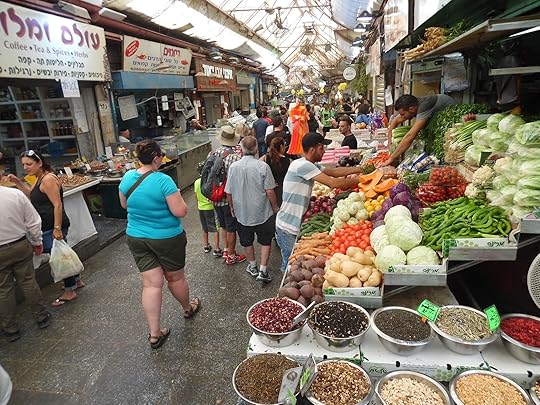 Following coffee he took us to the pedestrian grocery shuk (market), Mechane Yehuda, a few blocks away. We visited a crowded pre-Shabbat market with every kind of food available. We purchased halva and cherries. We also heard a man playing the electric guitar as we waited for the group to finish shopping.
Following coffee he took us to the pedestrian grocery shuk (market), Mechane Yehuda, a few blocks away. We visited a crowded pre-Shabbat market with every kind of food available. We purchased halva and cherries. We also heard a man playing the electric guitar as we waited for the group to finish shopping.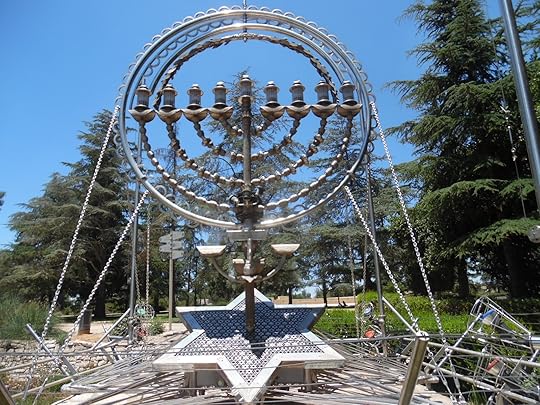 After shopping we parted ways with the group, taking the light rail to Mt. Herzl. There is a cemetery there for Israel’s heroes. Theodor Herzl is buried at the top of the mountain, over which the views are spectacular.
After shopping we parted ways with the group, taking the light rail to Mt. Herzl. There is a cemetery there for Israel’s heroes. Theodor Herzl is buried at the top of the mountain, over which the views are spectacular.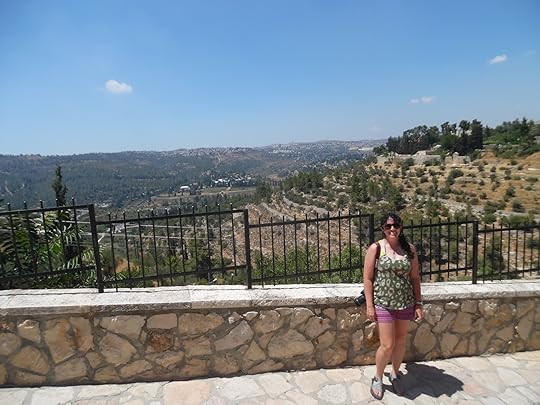 We boarded a bus from there to Ein-Kerem, the home town of Zechariah and Elizabeth. As we rode through the terrain and entered the village I thought about my book Advent Journeys, which in Week 2 looks at the route Zechariah the Priest and Joseph, the father of Jesus, travel to the Temple. I could clearly pick out the route.
We boarded a bus from there to Ein-Kerem, the home town of Zechariah and Elizabeth. As we rode through the terrain and entered the village I thought about my book Advent Journeys, which in Week 2 looks at the route Zechariah the Priest and Joseph, the father of Jesus, travel to the Temple. I could clearly pick out the route.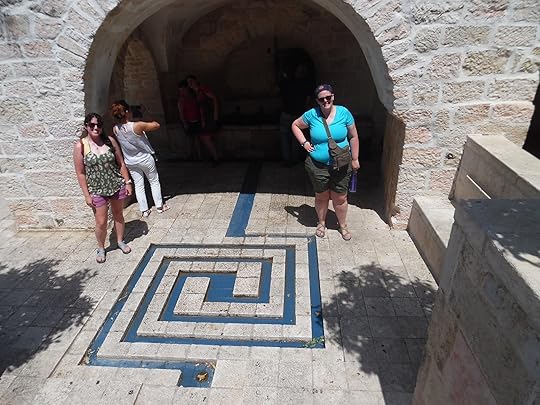 The village is in a valley formed by a spring, called Mary’s Spring, where water is constantly running. Above the spring we walked up the mountain to the Church of Visitation. We saw many other pilgrims also visiting the church. We also visited the church of St. John the Baptist, a Franciscan mission. We took a break at a nearby shop and drank Coke while watching pilgrims making their way to the Catholic sites in the area.
The village is in a valley formed by a spring, called Mary’s Spring, where water is constantly running. Above the spring we walked up the mountain to the Church of Visitation. We saw many other pilgrims also visiting the church. We also visited the church of St. John the Baptist, a Franciscan mission. We took a break at a nearby shop and drank Coke while watching pilgrims making their way to the Catholic sites in the area.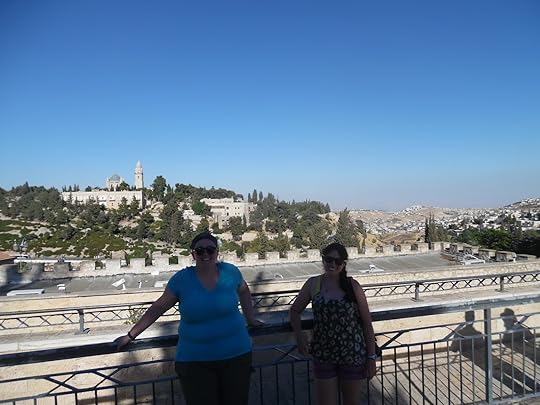 From Ein-Kerem we took the light rail back to the Damascus gate. We entered Jerusalem; it was crowded and noisy. It was Ramadan and also Erev Shabbat (the evening Sabbath begins). Shopkeepers were announcing their wares. Many women in their Burkas were in the streets. We made our way through the Old City to the Jaffa Gate, where we crossed the street and entered a park. In the park there were fountains and children playing. It was a hot day and the Sabbath.
From Ein-Kerem we took the light rail back to the Damascus gate. We entered Jerusalem; it was crowded and noisy. It was Ramadan and also Erev Shabbat (the evening Sabbath begins). Shopkeepers were announcing their wares. Many women in their Burkas were in the streets. We made our way through the Old City to the Jaffa Gate, where we crossed the street and entered a park. In the park there were fountains and children playing. It was a hot day and the Sabbath.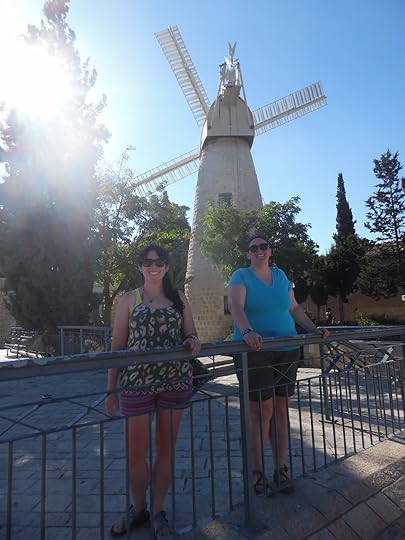 We continued past the Artists’ Colony (closed for Sabbath) to the Windmill and Lion’s fountain. Chelsea and Sarah had fun walking in the water. Then we came home.
We continued past the Artists’ Colony (closed for Sabbath) to the Windmill and Lion’s fountain. Chelsea and Sarah had fun walking in the water. Then we came home.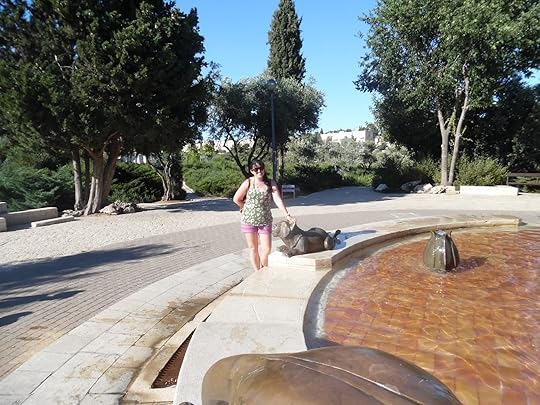 After a rest at home we visited Shira Hadasha Synagogue, a Modern Orthodox place of worship about one block away. Most of the worship liturgy was sung. Worship held our attention (even though it was in Hebrew), and was a great way to end the day.
After a rest at home we visited Shira Hadasha Synagogue, a Modern Orthodox place of worship about one block away. Most of the worship liturgy was sung. Worship held our attention (even though it was in Hebrew), and was a great way to end the day.
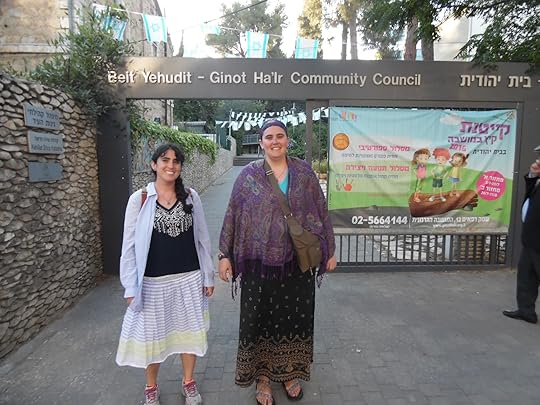
 Following coffee he took us to the pedestrian grocery shuk (market), Mechane Yehuda, a few blocks away. We visited a crowded pre-Shabbat market with every kind of food available. We purchased halva and cherries. We also heard a man playing the electric guitar as we waited for the group to finish shopping.
Following coffee he took us to the pedestrian grocery shuk (market), Mechane Yehuda, a few blocks away. We visited a crowded pre-Shabbat market with every kind of food available. We purchased halva and cherries. We also heard a man playing the electric guitar as we waited for the group to finish shopping. After shopping we parted ways with the group, taking the light rail to Mt. Herzl. There is a cemetery there for Israel’s heroes. Theodor Herzl is buried at the top of the mountain, over which the views are spectacular.
After shopping we parted ways with the group, taking the light rail to Mt. Herzl. There is a cemetery there for Israel’s heroes. Theodor Herzl is buried at the top of the mountain, over which the views are spectacular. We boarded a bus from there to Ein-Kerem, the home town of Zechariah and Elizabeth. As we rode through the terrain and entered the village I thought about my book Advent Journeys, which in Week 2 looks at the route Zechariah the Priest and Joseph, the father of Jesus, travel to the Temple. I could clearly pick out the route.
We boarded a bus from there to Ein-Kerem, the home town of Zechariah and Elizabeth. As we rode through the terrain and entered the village I thought about my book Advent Journeys, which in Week 2 looks at the route Zechariah the Priest and Joseph, the father of Jesus, travel to the Temple. I could clearly pick out the route. The village is in a valley formed by a spring, called Mary’s Spring, where water is constantly running. Above the spring we walked up the mountain to the Church of Visitation. We saw many other pilgrims also visiting the church. We also visited the church of St. John the Baptist, a Franciscan mission. We took a break at a nearby shop and drank Coke while watching pilgrims making their way to the Catholic sites in the area.
The village is in a valley formed by a spring, called Mary’s Spring, where water is constantly running. Above the spring we walked up the mountain to the Church of Visitation. We saw many other pilgrims also visiting the church. We also visited the church of St. John the Baptist, a Franciscan mission. We took a break at a nearby shop and drank Coke while watching pilgrims making their way to the Catholic sites in the area. From Ein-Kerem we took the light rail back to the Damascus gate. We entered Jerusalem; it was crowded and noisy. It was Ramadan and also Erev Shabbat (the evening Sabbath begins). Shopkeepers were announcing their wares. Many women in their Burkas were in the streets. We made our way through the Old City to the Jaffa Gate, where we crossed the street and entered a park. In the park there were fountains and children playing. It was a hot day and the Sabbath.
From Ein-Kerem we took the light rail back to the Damascus gate. We entered Jerusalem; it was crowded and noisy. It was Ramadan and also Erev Shabbat (the evening Sabbath begins). Shopkeepers were announcing their wares. Many women in their Burkas were in the streets. We made our way through the Old City to the Jaffa Gate, where we crossed the street and entered a park. In the park there were fountains and children playing. It was a hot day and the Sabbath. We continued past the Artists’ Colony (closed for Sabbath) to the Windmill and Lion’s fountain. Chelsea and Sarah had fun walking in the water. Then we came home.
We continued past the Artists’ Colony (closed for Sabbath) to the Windmill and Lion’s fountain. Chelsea and Sarah had fun walking in the water. Then we came home. After a rest at home we visited Shira Hadasha Synagogue, a Modern Orthodox place of worship about one block away. Most of the worship liturgy was sung. Worship held our attention (even though it was in Hebrew), and was a great way to end the day.
After a rest at home we visited Shira Hadasha Synagogue, a Modern Orthodox place of worship about one block away. Most of the worship liturgy was sung. Worship held our attention (even though it was in Hebrew), and was a great way to end the day.
Published on June 17, 2016 12:11
Israel Adventure - Day 8
Today started with a bagel, cream cheese and cappuccino. What else? When in Jerusalem do as the community does. And my mother taught us to love bagels.After breakfast Stephen and I took the bus to Hebrew University. The bus gave us a great ride through town. (Steve has never been here before). I pointed out German Community, the Old City, The Government Center (roads to Knesset and the Israel Museum), We passed through an Orthodox neighborhood, and then did a roundabout at the Bus and Light Rail station. From that point the bus went up hill to the top of Mount Scopus. (2710 feet).We entered the university from the bus terminal. We went through security, and looked for information. We ended up at the Library, where the security guard could not help us, but a librarian was just entering. She gave us an orientation, took us to the Synagogue and look out point of the University. The view was OUTSTANDING!! We could see everything with a 200+ degree view.  From the viewpoint of all Jerusalem we walked across the campus of the University to see the Biblical gardens on the east side of the campus. The gardens contain sections of plants from every area of Israel, which are all well labeled. As we walked through the gardens we came across a graveyard from the first century. The hillside was catacombed with tombs containing ossuaries (Boxes where bones are kept after the body decomposes). One of the graves belonged to Nicanor of Alexandria. Nicanor was the donor of the bronze doors of the Court of the Women in the second temple.
From the viewpoint of all Jerusalem we walked across the campus of the University to see the Biblical gardens on the east side of the campus. The gardens contain sections of plants from every area of Israel, which are all well labeled. As we walked through the gardens we came across a graveyard from the first century. The hillside was catacombed with tombs containing ossuaries (Boxes where bones are kept after the body decomposes). One of the graves belonged to Nicanor of Alexandria. Nicanor was the donor of the bronze doors of the Court of the Women in the second temple.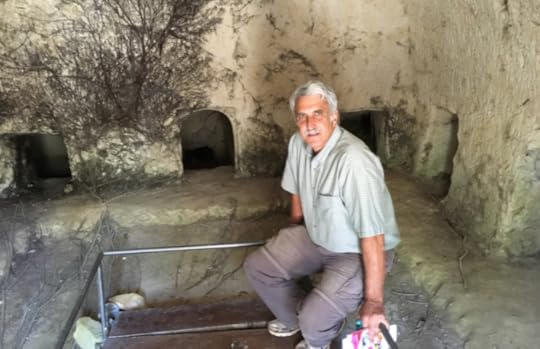 We continued through the gardens to the northern side where there is a vantage point in the Yitzak Rabin building looking north and east. We could see the Jordan River, Jericho, Mizpah, and Anathoth (where Jeremiah was born).
We continued through the gardens to the northern side where there is a vantage point in the Yitzak Rabin building looking north and east. We could see the Jordan River, Jericho, Mizpah, and Anathoth (where Jeremiah was born).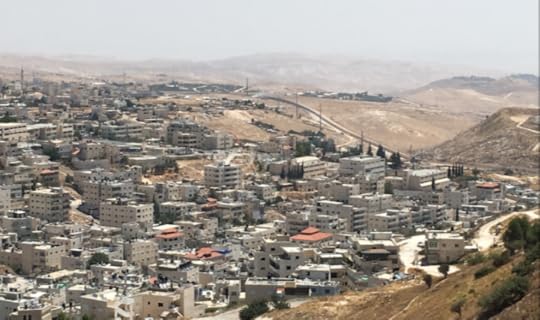 From the gardens we went to the Archeological Museum which was amazing. We saw painted walls from Dura-Europo, and findings from many other sites in Israel. Following our exploration of Hebrew University we descended the hill through Tabatznik National Park Israel, which is part of the University. We had great views of the Dome of the Rock, and thought about what the area looked like to Jesus as he and the Disciples may have taken this path to the Temple.
From the gardens we went to the Archeological Museum which was amazing. We saw painted walls from Dura-Europo, and findings from many other sites in Israel. Following our exploration of Hebrew University we descended the hill through Tabatznik National Park Israel, which is part of the University. We had great views of the Dome of the Rock, and thought about what the area looked like to Jesus as he and the Disciples may have taken this path to the Temple.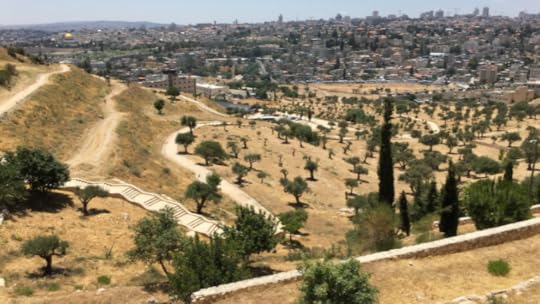 We continued to descend into Emek Tzurim National Park, which contains “the king’s highway.” It also contains the Temple Sifting Project. In 1996 the Muslims illegally dug an entrance for Al-Aqsa Mosque, removing over 900 dump truck loads of soil. Although Archeologists cannot determine levels where artifacts are found, many treasures are found by people who help sift through debris to find remains of ages past from Temple Mount. We found nails, pottery, mosaic tiles, bones, glass and other items.
We continued to descend into Emek Tzurim National Park, which contains “the king’s highway.” It also contains the Temple Sifting Project. In 1996 the Muslims illegally dug an entrance for Al-Aqsa Mosque, removing over 900 dump truck loads of soil. Although Archeologists cannot determine levels where artifacts are found, many treasures are found by people who help sift through debris to find remains of ages past from Temple Mount. We found nails, pottery, mosaic tiles, bones, glass and other items.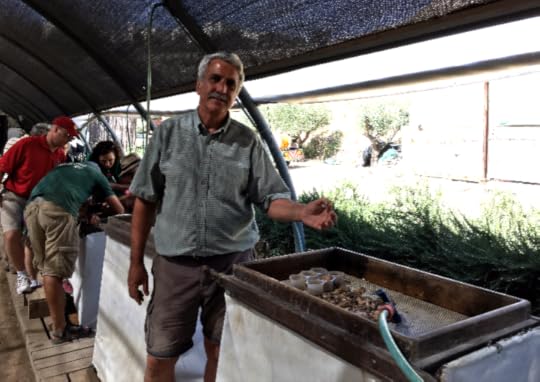 From our dig we descended, then ascended to the walled city of Jerusalem. We entered Herod's Gate and got lost. We wandered through the Muslim Quarter. We made it to the entrance of the Western Wall, but there was a long line to get in, so we backtracked. We paid a child 10 shillings to take us to the Jaffa gate, but he took us to the Damascus gate. I then pulled out my map, and we found the Jaffa Gate, crossed the highway and walked home. We were very tired
From our dig we descended, then ascended to the walled city of Jerusalem. We entered Herod's Gate and got lost. We wandered through the Muslim Quarter. We made it to the entrance of the Western Wall, but there was a long line to get in, so we backtracked. We paid a child 10 shillings to take us to the Jaffa gate, but he took us to the Damascus gate. I then pulled out my map, and we found the Jaffa Gate, crossed the highway and walked home. We were very tired
I ate a dinner of Mina Chicken Noodle Soup with Chelsea and Sarah and then went to bed.
 From the viewpoint of all Jerusalem we walked across the campus of the University to see the Biblical gardens on the east side of the campus. The gardens contain sections of plants from every area of Israel, which are all well labeled. As we walked through the gardens we came across a graveyard from the first century. The hillside was catacombed with tombs containing ossuaries (Boxes where bones are kept after the body decomposes). One of the graves belonged to Nicanor of Alexandria. Nicanor was the donor of the bronze doors of the Court of the Women in the second temple.
From the viewpoint of all Jerusalem we walked across the campus of the University to see the Biblical gardens on the east side of the campus. The gardens contain sections of plants from every area of Israel, which are all well labeled. As we walked through the gardens we came across a graveyard from the first century. The hillside was catacombed with tombs containing ossuaries (Boxes where bones are kept after the body decomposes). One of the graves belonged to Nicanor of Alexandria. Nicanor was the donor of the bronze doors of the Court of the Women in the second temple. We continued through the gardens to the northern side where there is a vantage point in the Yitzak Rabin building looking north and east. We could see the Jordan River, Jericho, Mizpah, and Anathoth (where Jeremiah was born).
We continued through the gardens to the northern side where there is a vantage point in the Yitzak Rabin building looking north and east. We could see the Jordan River, Jericho, Mizpah, and Anathoth (where Jeremiah was born). From the gardens we went to the Archeological Museum which was amazing. We saw painted walls from Dura-Europo, and findings from many other sites in Israel. Following our exploration of Hebrew University we descended the hill through Tabatznik National Park Israel, which is part of the University. We had great views of the Dome of the Rock, and thought about what the area looked like to Jesus as he and the Disciples may have taken this path to the Temple.
From the gardens we went to the Archeological Museum which was amazing. We saw painted walls from Dura-Europo, and findings from many other sites in Israel. Following our exploration of Hebrew University we descended the hill through Tabatznik National Park Israel, which is part of the University. We had great views of the Dome of the Rock, and thought about what the area looked like to Jesus as he and the Disciples may have taken this path to the Temple. We continued to descend into Emek Tzurim National Park, which contains “the king’s highway.” It also contains the Temple Sifting Project. In 1996 the Muslims illegally dug an entrance for Al-Aqsa Mosque, removing over 900 dump truck loads of soil. Although Archeologists cannot determine levels where artifacts are found, many treasures are found by people who help sift through debris to find remains of ages past from Temple Mount. We found nails, pottery, mosaic tiles, bones, glass and other items.
We continued to descend into Emek Tzurim National Park, which contains “the king’s highway.” It also contains the Temple Sifting Project. In 1996 the Muslims illegally dug an entrance for Al-Aqsa Mosque, removing over 900 dump truck loads of soil. Although Archeologists cannot determine levels where artifacts are found, many treasures are found by people who help sift through debris to find remains of ages past from Temple Mount. We found nails, pottery, mosaic tiles, bones, glass and other items. From our dig we descended, then ascended to the walled city of Jerusalem. We entered Herod's Gate and got lost. We wandered through the Muslim Quarter. We made it to the entrance of the Western Wall, but there was a long line to get in, so we backtracked. We paid a child 10 shillings to take us to the Jaffa gate, but he took us to the Damascus gate. I then pulled out my map, and we found the Jaffa Gate, crossed the highway and walked home. We were very tired
From our dig we descended, then ascended to the walled city of Jerusalem. We entered Herod's Gate and got lost. We wandered through the Muslim Quarter. We made it to the entrance of the Western Wall, but there was a long line to get in, so we backtracked. We paid a child 10 shillings to take us to the Jaffa gate, but he took us to the Damascus gate. I then pulled out my map, and we found the Jaffa Gate, crossed the highway and walked home. We were very tiredI ate a dinner of Mina Chicken Noodle Soup with Chelsea and Sarah and then went to bed.
Published on June 17, 2016 07:37
June 15, 2016
Israel Adventure - Day 7
Today is our last day in Tel-Aviv. Later this afternoon we will turn in the car, meet the group from Hebrew Union College, and drive to Jerusalem. 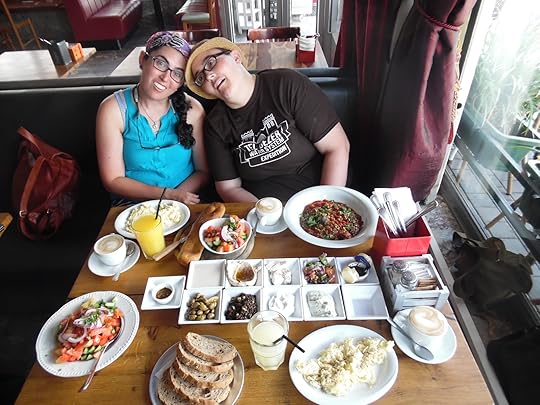 We returned for breakfast today to the Cafe Yaffo and ate two of their breakfast specials: Israeli breakfast for two and eggplant shakshuka. As you can tell from the picture it was PLENTY! We enjoyed the food, and brought a little home. The cafe is located in the flea market district, and from our booth you can see the horse which passed our window.
We returned for breakfast today to the Cafe Yaffo and ate two of their breakfast specials: Israeli breakfast for two and eggplant shakshuka. As you can tell from the picture it was PLENTY! We enjoyed the food, and brought a little home. The cafe is located in the flea market district, and from our booth you can see the horse which passed our window.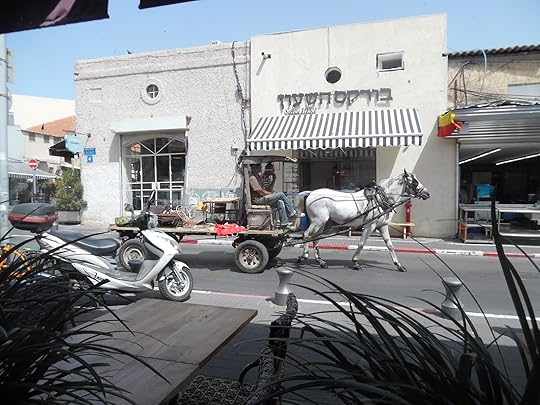 After breakfast we went to Old Jaffa. Ruins are preserved beneath the plaza and we went in to see the exhibit and the multimedia multiexperiential movie. They told the story of how Jaffa is one of the oldest cities in the world, started by Noah’s son Japeth (tradition).
After breakfast we went to Old Jaffa. Ruins are preserved beneath the plaza and we went in to see the exhibit and the multimedia multiexperiential movie. They told the story of how Jaffa is one of the oldest cities in the world, started by Noah’s son Japeth (tradition).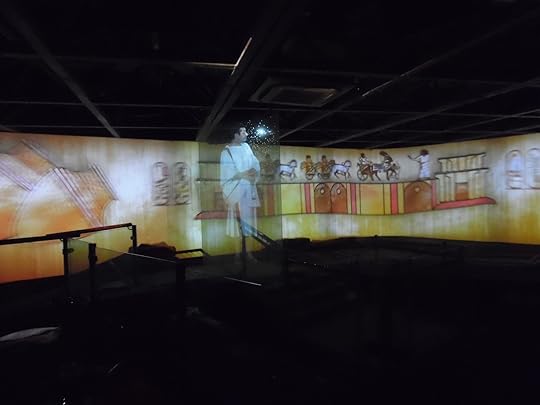 They had a video with the Roman agronomist (wine-taster) Judah speaking from his home (which was uncovered in an excavation - the ruins are now the location of the museum). Different people came to visit him at his home. The first was a Pharaoh, pictured above. Egypt conquered Jaffa several times.
They had a video with the Roman agronomist (wine-taster) Judah speaking from his home (which was uncovered in an excavation - the ruins are now the location of the museum). Different people came to visit him at his home. The first was a Pharaoh, pictured above. Egypt conquered Jaffa several times.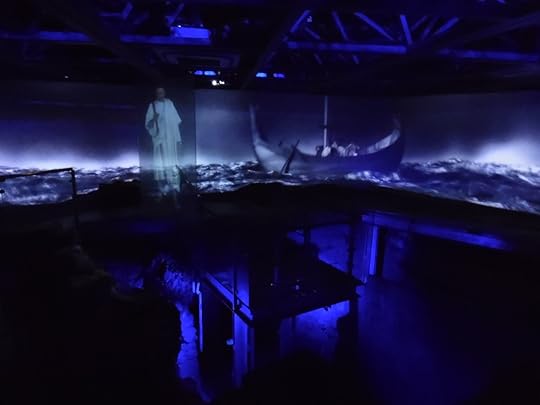 A second visitor was Jonah, who was running from God.
A second visitor was Jonah, who was running from God.
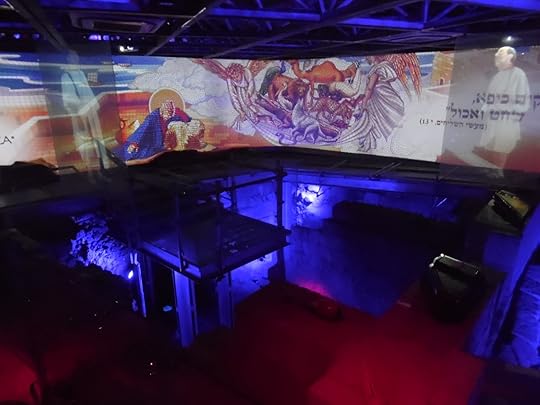 A third section was on Peter’s vision of the animals.
A third section was on Peter’s vision of the animals. 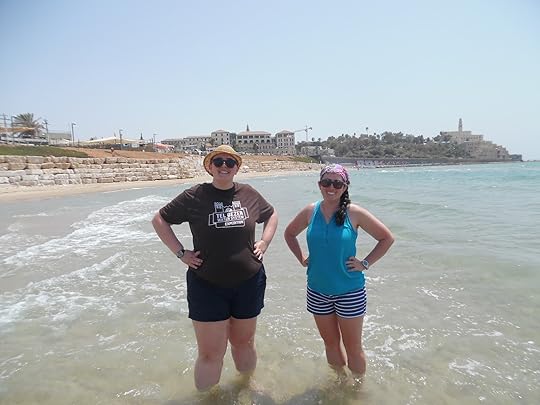 After our visit to Old Jaffa, we went into the Mediterranean once again. We did not take swim suits, so we only waded into the water. The water cooled us off, and as this was our last day in Jaffa, we wanted to take advantage of the afternoon.
After our visit to Old Jaffa, we went into the Mediterranean once again. We did not take swim suits, so we only waded into the water. The water cooled us off, and as this was our last day in Jaffa, we wanted to take advantage of the afternoon.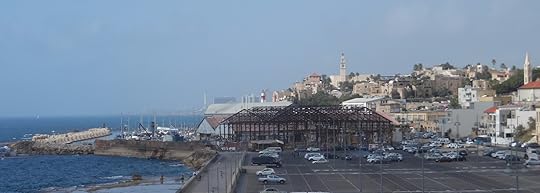 After our wade in the sea, Chelsea and Sarah went to pack, and I climbed a hill south of Jaffa, created as a greenspace in Jaffa. In this picture you can see the old harbor (left), the wharfs (straight ahead), and the Old City, with the Catholic Church at the top. There is also a lighthouse. Busses use the lot in the front to wait for tour groups.
After our wade in the sea, Chelsea and Sarah went to pack, and I climbed a hill south of Jaffa, created as a greenspace in Jaffa. In this picture you can see the old harbor (left), the wharfs (straight ahead), and the Old City, with the Catholic Church at the top. There is also a lighthouse. Busses use the lot in the front to wait for tour groups.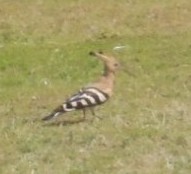 While on top of the hill a hoopoe was pointed out to me. This is Israel’s state bird. After climbing the hill, I returned to the apartment, we packed the car, and left Jaffa for Jerusalem.
While on top of the hill a hoopoe was pointed out to me. This is Israel’s state bird. After climbing the hill, I returned to the apartment, we packed the car, and left Jaffa for Jerusalem.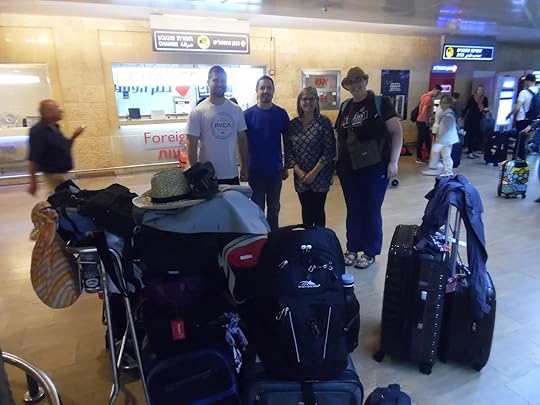 On the way we met the group Chelsea will be working with this summer at Ben-Gurion airport. We shared a shuttle ride to our apartment (pictured below)
On the way we met the group Chelsea will be working with this summer at Ben-Gurion airport. We shared a shuttle ride to our apartment (pictured below)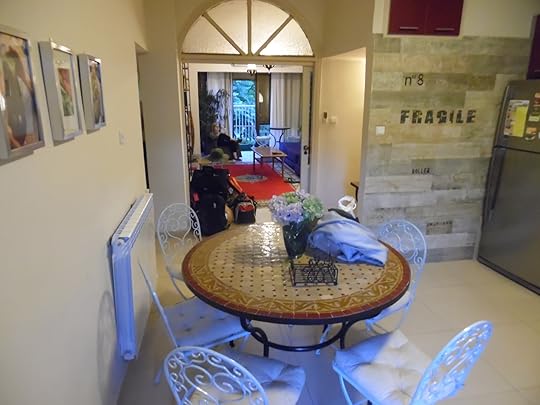 After settling into the apartment we went to Jerusalem’s first train station, which has been turned into an outdoor mall. They consistently have special events. They had a huge book sale going on in the middle of the train station. We ate dinner there, and returned to our apartment in Jerusalem.
After settling into the apartment we went to Jerusalem’s first train station, which has been turned into an outdoor mall. They consistently have special events. They had a huge book sale going on in the middle of the train station. We ate dinner there, and returned to our apartment in Jerusalem.
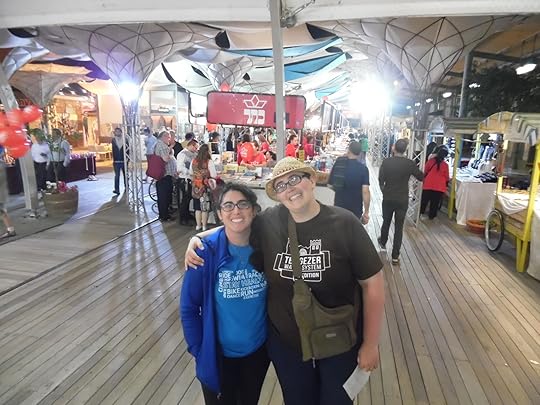
 We returned for breakfast today to the Cafe Yaffo and ate two of their breakfast specials: Israeli breakfast for two and eggplant shakshuka. As you can tell from the picture it was PLENTY! We enjoyed the food, and brought a little home. The cafe is located in the flea market district, and from our booth you can see the horse which passed our window.
We returned for breakfast today to the Cafe Yaffo and ate two of their breakfast specials: Israeli breakfast for two and eggplant shakshuka. As you can tell from the picture it was PLENTY! We enjoyed the food, and brought a little home. The cafe is located in the flea market district, and from our booth you can see the horse which passed our window. After breakfast we went to Old Jaffa. Ruins are preserved beneath the plaza and we went in to see the exhibit and the multimedia multiexperiential movie. They told the story of how Jaffa is one of the oldest cities in the world, started by Noah’s son Japeth (tradition).
After breakfast we went to Old Jaffa. Ruins are preserved beneath the plaza and we went in to see the exhibit and the multimedia multiexperiential movie. They told the story of how Jaffa is one of the oldest cities in the world, started by Noah’s son Japeth (tradition). They had a video with the Roman agronomist (wine-taster) Judah speaking from his home (which was uncovered in an excavation - the ruins are now the location of the museum). Different people came to visit him at his home. The first was a Pharaoh, pictured above. Egypt conquered Jaffa several times.
They had a video with the Roman agronomist (wine-taster) Judah speaking from his home (which was uncovered in an excavation - the ruins are now the location of the museum). Different people came to visit him at his home. The first was a Pharaoh, pictured above. Egypt conquered Jaffa several times. A second visitor was Jonah, who was running from God.
A second visitor was Jonah, who was running from God.
 A third section was on Peter’s vision of the animals.
A third section was on Peter’s vision of the animals.  After our visit to Old Jaffa, we went into the Mediterranean once again. We did not take swim suits, so we only waded into the water. The water cooled us off, and as this was our last day in Jaffa, we wanted to take advantage of the afternoon.
After our visit to Old Jaffa, we went into the Mediterranean once again. We did not take swim suits, so we only waded into the water. The water cooled us off, and as this was our last day in Jaffa, we wanted to take advantage of the afternoon. After our wade in the sea, Chelsea and Sarah went to pack, and I climbed a hill south of Jaffa, created as a greenspace in Jaffa. In this picture you can see the old harbor (left), the wharfs (straight ahead), and the Old City, with the Catholic Church at the top. There is also a lighthouse. Busses use the lot in the front to wait for tour groups.
After our wade in the sea, Chelsea and Sarah went to pack, and I climbed a hill south of Jaffa, created as a greenspace in Jaffa. In this picture you can see the old harbor (left), the wharfs (straight ahead), and the Old City, with the Catholic Church at the top. There is also a lighthouse. Busses use the lot in the front to wait for tour groups. While on top of the hill a hoopoe was pointed out to me. This is Israel’s state bird. After climbing the hill, I returned to the apartment, we packed the car, and left Jaffa for Jerusalem.
While on top of the hill a hoopoe was pointed out to me. This is Israel’s state bird. After climbing the hill, I returned to the apartment, we packed the car, and left Jaffa for Jerusalem. On the way we met the group Chelsea will be working with this summer at Ben-Gurion airport. We shared a shuttle ride to our apartment (pictured below)
On the way we met the group Chelsea will be working with this summer at Ben-Gurion airport. We shared a shuttle ride to our apartment (pictured below) After settling into the apartment we went to Jerusalem’s first train station, which has been turned into an outdoor mall. They consistently have special events. They had a huge book sale going on in the middle of the train station. We ate dinner there, and returned to our apartment in Jerusalem.
After settling into the apartment we went to Jerusalem’s first train station, which has been turned into an outdoor mall. They consistently have special events. They had a huge book sale going on in the middle of the train station. We ate dinner there, and returned to our apartment in Jerusalem.
Published on June 15, 2016 13:17
Israel Adventure - Day 6
Today was Founder's day on our Israel trip. We went downtown to see the patriotic side of Israel. The story of independence is more detailed, full of valor and greater than most people know, or could even guess.As we drove to our destination it became obvious that the holiday, Shavuot, was over and traffic was crazy! Cars would not stay in their lanes and motorcycles drove all over the place. In Tel-Aviv a driver must also watch for pedestrians and bicycle riders who come out of nowhere into the crosswalks. 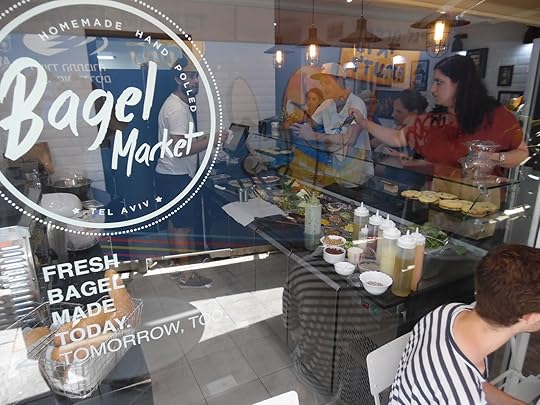 We began with breakfast at the Bagel Market - only, the bagel machine of the bagel market had broken, so we had fresh baguettes instead. This was one of the only bagel places in Tel Aviv, which was why we ate there. Even though there were no bagels, the breakfast was excellent. We had lox and a choice of many vegetables.
We began with breakfast at the Bagel Market - only, the bagel machine of the bagel market had broken, so we had fresh baguettes instead. This was one of the only bagel places in Tel Aviv, which was why we ate there. Even though there were no bagels, the breakfast was excellent. We had lox and a choice of many vegetables.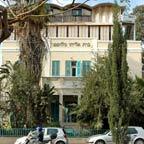 From breakfast we walked several blocks to Rothschild Blvd. Our first stop was the Haganah Museum. The museum is in Eliyahu Golomb’s old house. He was one of the original founders of the Jewish yishuv. The house was once was headquarters for the 71,000 member organization. This organization pre-dated and became the Israeli Defense Forces. Most of the commanders were members of the Haganah, and the eventual Prime Ministers of Israel all had a connection as well.
From breakfast we walked several blocks to Rothschild Blvd. Our first stop was the Haganah Museum. The museum is in Eliyahu Golomb’s old house. He was one of the original founders of the Jewish yishuv. The house was once was headquarters for the 71,000 member organization. This organization pre-dated and became the Israeli Defense Forces. Most of the commanders were members of the Haganah, and the eventual Prime Ministers of Israel all had a connection as well.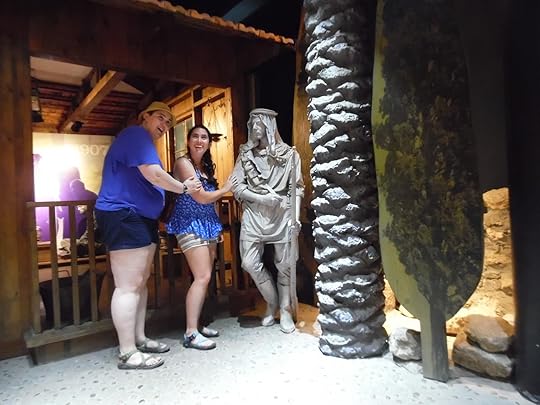 The Haganah grew out of the Zionist movement of the 1890s. At that time there was a desire to “return to the homeland.” Farms were established by Baron Rothschild to produce marketable goods. Through the philosophy of Theodor Herzl, European Jews moved to farming collectives called kibbutzim. Although the two were not in total agreement about how to settle the nation (if you have two Jews you have five opinions), in the end both methods of establishing settlement worked for the greater good.
The Haganah grew out of the Zionist movement of the 1890s. At that time there was a desire to “return to the homeland.” Farms were established by Baron Rothschild to produce marketable goods. Through the philosophy of Theodor Herzl, European Jews moved to farming collectives called kibbutzim. Although the two were not in total agreement about how to settle the nation (if you have two Jews you have five opinions), in the end both methods of establishing settlement worked for the greater good.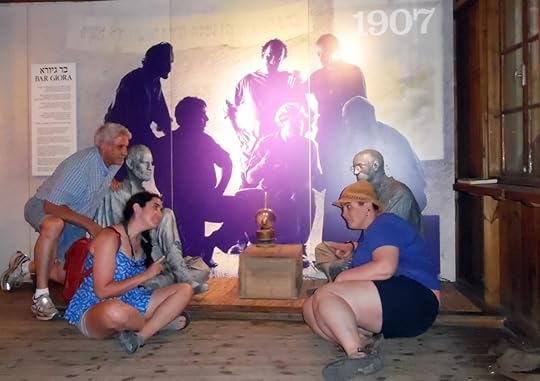 By the end of World War I, the rapid pace of European Jewish immigration was turning the tide in Palestine politically. The Arabs, who did not like the Europeans from the beginning, saw themselves as losing clout. They began attacking the Kibbutzim. The settlers began police forces to protect themselves. Community police began to work together and train together in order to increase skills.
By the end of World War I, the rapid pace of European Jewish immigration was turning the tide in Palestine politically. The Arabs, who did not like the Europeans from the beginning, saw themselves as losing clout. They began attacking the Kibbutzim. The settlers began police forces to protect themselves. Community police began to work together and train together in order to increase skills.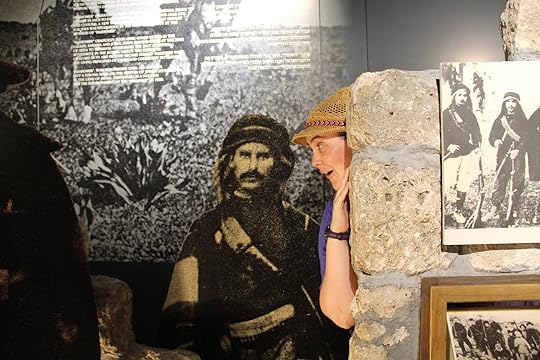 The Arabs continued to push England on the matter, and finally in 1939, the British government caved in and issued what is called “the White Paper” - forbidding Jewish immigration to Palestine. The British would blockade Mediterranean ports, and if immigrants were found, send them back to Europe and Germany in order to suffer whatever fate they may. The Haganah created diversions and found ways to smuggle the immigrants into Israel. They also declared war on England, a sort of revolution, letting the ruling government know they needed to lift the embargo on persecuted people. (Hitler was already in power in Germany!)
The Arabs continued to push England on the matter, and finally in 1939, the British government caved in and issued what is called “the White Paper” - forbidding Jewish immigration to Palestine. The British would blockade Mediterranean ports, and if immigrants were found, send them back to Europe and Germany in order to suffer whatever fate they may. The Haganah created diversions and found ways to smuggle the immigrants into Israel. They also declared war on England, a sort of revolution, letting the ruling government know they needed to lift the embargo on persecuted people. (Hitler was already in power in Germany!)
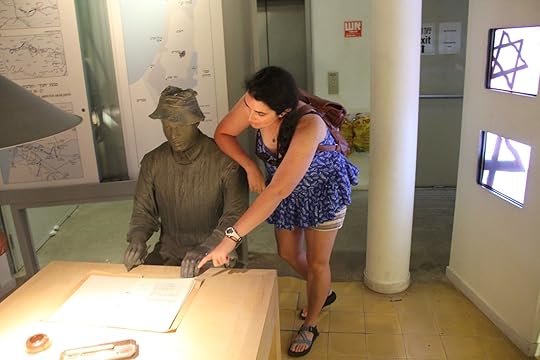 Several officers who had served in the army during World War I served as visionaries in this movement and began to strategize Israel’s future (some were members of the Jewish Legion, which was the first organized army marching under the Jewish banner since the destruction of the Jewish homeland in 70-135 AD). They encouraged and nurtured organization between villages and kibbutzim. They organized Jewish leaders around the world with the dream of a Jewish homeland (although the Jewish people had lived in Diaspora among the nations for over 2,000 years, periods of anti-Semitism arise even in nations once favorable to Jewish settlement). Two prominent leaders of this movement were David Ben-Gurion from Poland (he also lived in New York City for three years) and Chaim Weizmann of Russia (who moved to England).
Several officers who had served in the army during World War I served as visionaries in this movement and began to strategize Israel’s future (some were members of the Jewish Legion, which was the first organized army marching under the Jewish banner since the destruction of the Jewish homeland in 70-135 AD). They encouraged and nurtured organization between villages and kibbutzim. They organized Jewish leaders around the world with the dream of a Jewish homeland (although the Jewish people had lived in Diaspora among the nations for over 2,000 years, periods of anti-Semitism arise even in nations once favorable to Jewish settlement). Two prominent leaders of this movement were David Ben-Gurion from Poland (he also lived in New York City for three years) and Chaim Weizmann of Russia (who moved to England). 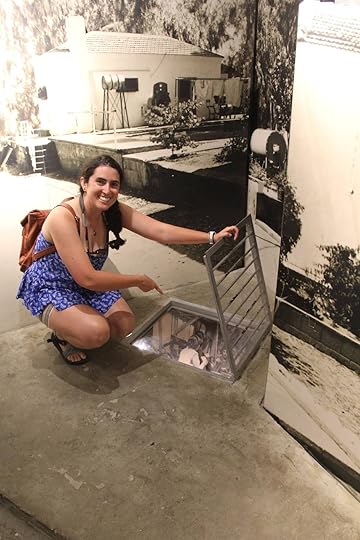 The war between England and the Haganah began as skirmishes...and the eruption of World War II shook the world, including Israel and the Jews’ ongoing conflict with the British colonialists. The Haganah enlisted men and women to fight with England against the common enemy. They also enlisted spies to find concentration camps and release prisoners when possible (and when they found prisoners, released them, and brought them to Israel, there was a high chance the British would turn the ships around and send them back to Germany!).
The war between England and the Haganah began as skirmishes...and the eruption of World War II shook the world, including Israel and the Jews’ ongoing conflict with the British colonialists. The Haganah enlisted men and women to fight with England against the common enemy. They also enlisted spies to find concentration camps and release prisoners when possible (and when they found prisoners, released them, and brought them to Israel, there was a high chance the British would turn the ships around and send them back to Germany!).
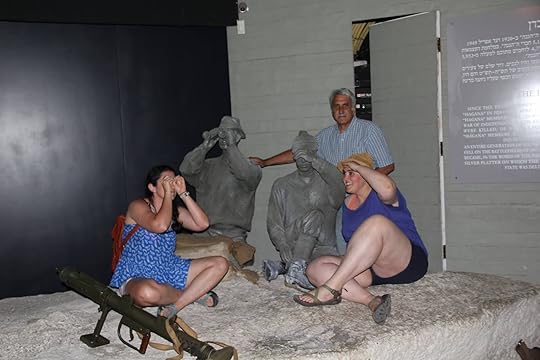 After the war, planning began again with strategized terror attacks on bridges, trains, radio, and radar stations. The attacks were always planned to minimize loss of life even while accomplishing desired results - and they were successful. Eventually England (who would not make a decision to free Palestine) asked the United Nations to vote on what to do with Palestine. The land was divided between Jews and Arabs, opening the door for a Jewish homeland (although drastic changes to the UN’s plan would be necessary to make this homeland a reality).
After the war, planning began again with strategized terror attacks on bridges, trains, radio, and radar stations. The attacks were always planned to minimize loss of life even while accomplishing desired results - and they were successful. Eventually England (who would not make a decision to free Palestine) asked the United Nations to vote on what to do with Palestine. The land was divided between Jews and Arabs, opening the door for a Jewish homeland (although drastic changes to the UN’s plan would be necessary to make this homeland a reality). 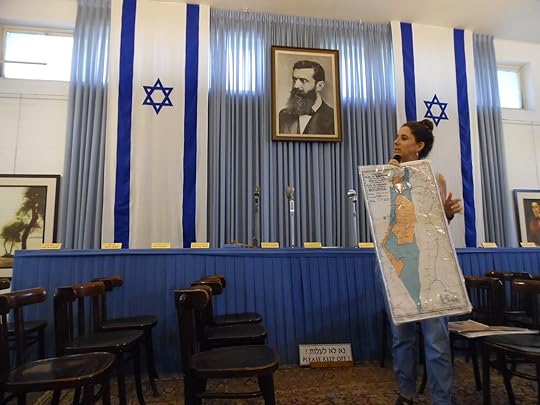 The museum shared stories of bravery as the Jewish military was organized, even before the nation of Israel was born, which is fortunate, for the day after the nation’s birth it was attacked by Arabs, and survived (although the first attacks by the Arabs began six months prior, just after the UN plan was affirmed).A block away, on the other side of Rothschild Blvd, there exists a building known as Israel’s Independence Hall. This was actually the home of Tel-Aviv’s first mayor, Meir Dizengoff.
The museum shared stories of bravery as the Jewish military was organized, even before the nation of Israel was born, which is fortunate, for the day after the nation’s birth it was attacked by Arabs, and survived (although the first attacks by the Arabs began six months prior, just after the UN plan was affirmed).A block away, on the other side of Rothschild Blvd, there exists a building known as Israel’s Independence Hall. This was actually the home of Tel-Aviv’s first mayor, Meir Dizengoff.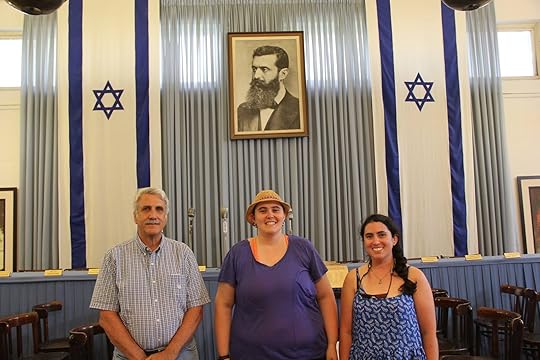 After the United Nations drew up a plan for Palestine’s partition and ended British rule on November 29, 1947, Jewish leaders met to take the opportunity to organize a government. (The Arabs disputed the plan because it did not give them all of the land, so they had not taken the opportunity to draw up a constitution and form a government. Various terrorist groups rule areas of Arab Palestine today.) On Friday (the Sabbath begins at sundown Friday and continues through Saturday - which is why the meeting did not take place the next day), May 14, 1948, the day before England was to pull out of Palestine, the Jewish people met at the Dizengoff home (in a room that was used as an art museum) to formally read the Declaration of Independence and assert their right to a land which had been theirs for over two thousand years. The event was put together rapidly, so it might be said Israel, the homeland of the Jewish people was formed in a day. (Isaiah 66:8)
After the United Nations drew up a plan for Palestine’s partition and ended British rule on November 29, 1947, Jewish leaders met to take the opportunity to organize a government. (The Arabs disputed the plan because it did not give them all of the land, so they had not taken the opportunity to draw up a constitution and form a government. Various terrorist groups rule areas of Arab Palestine today.) On Friday (the Sabbath begins at sundown Friday and continues through Saturday - which is why the meeting did not take place the next day), May 14, 1948, the day before England was to pull out of Palestine, the Jewish people met at the Dizengoff home (in a room that was used as an art museum) to formally read the Declaration of Independence and assert their right to a land which had been theirs for over two thousand years. The event was put together rapidly, so it might be said Israel, the homeland of the Jewish people was formed in a day. (Isaiah 66:8)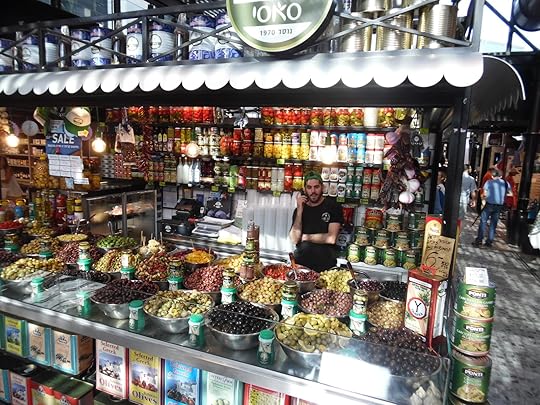 After our tour at Israel’s Independence Hall we walked to the Sarona Market, an upscale food market which is mostly contained in a mall. We ate dates and apricots for a snack and also had some ice cream.
After our tour at Israel’s Independence Hall we walked to the Sarona Market, an upscale food market which is mostly contained in a mall. We ate dates and apricots for a snack and also had some ice cream.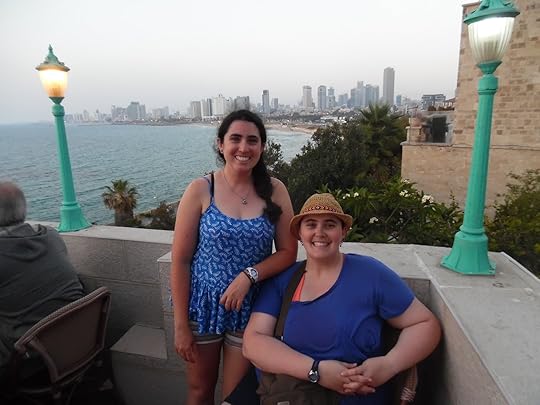 We then walked back to the car and drove back to our apartment. We had decided last night to eat at the Aladin restaurant in Old Jaffa with a patio above the Mediterranean. We went just before sunset. We sat down, almost immediately heard the call to prayer from the minaret next door, and seemingly in response the chiming of the hour by the bells at the Catholic church.I ordered beef kabobs, Chelsea had baked eggplant, and Sarah had mussels. We also ate tabouli. The food was tov meod (very good). The view was outstanding.
We then walked back to the car and drove back to our apartment. We had decided last night to eat at the Aladin restaurant in Old Jaffa with a patio above the Mediterranean. We went just before sunset. We sat down, almost immediately heard the call to prayer from the minaret next door, and seemingly in response the chiming of the hour by the bells at the Catholic church.I ordered beef kabobs, Chelsea had baked eggplant, and Sarah had mussels. We also ate tabouli. The food was tov meod (very good). The view was outstanding. 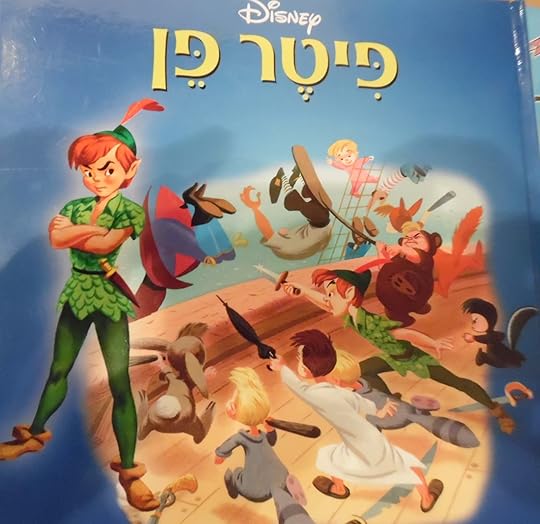 After dinner we walked along the wharfs at the harbor. Other restaurants such as the Old Man and the Sea line old warehouses. We looked at the boats, heard some music, visited an art shop (which also had some familiar books…can you read the title above?) and took some pictures.
After dinner we walked along the wharfs at the harbor. Other restaurants such as the Old Man and the Sea line old warehouses. We looked at the boats, heard some music, visited an art shop (which also had some familiar books…can you read the title above?) and took some pictures. 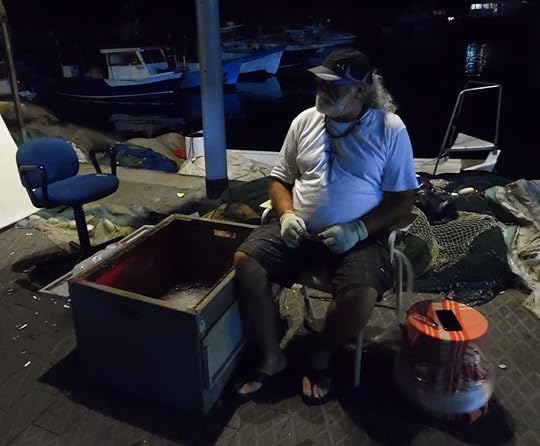 This is a picture of “Peter the Fisherman.” Although I do not know his real name, you can see the cross around his neck. He was preparing his lines for the next day.After our walk we went back to Old Jaffa (no, I did not yet find the bag I lost two years ago, but I looked!) for Ice Cream (what else?!) and to plan our day for tomorrow.
This is a picture of “Peter the Fisherman.” Although I do not know his real name, you can see the cross around his neck. He was preparing his lines for the next day.After our walk we went back to Old Jaffa (no, I did not yet find the bag I lost two years ago, but I looked!) for Ice Cream (what else?!) and to plan our day for tomorrow.
 We began with breakfast at the Bagel Market - only, the bagel machine of the bagel market had broken, so we had fresh baguettes instead. This was one of the only bagel places in Tel Aviv, which was why we ate there. Even though there were no bagels, the breakfast was excellent. We had lox and a choice of many vegetables.
We began with breakfast at the Bagel Market - only, the bagel machine of the bagel market had broken, so we had fresh baguettes instead. This was one of the only bagel places in Tel Aviv, which was why we ate there. Even though there were no bagels, the breakfast was excellent. We had lox and a choice of many vegetables. From breakfast we walked several blocks to Rothschild Blvd. Our first stop was the Haganah Museum. The museum is in Eliyahu Golomb’s old house. He was one of the original founders of the Jewish yishuv. The house was once was headquarters for the 71,000 member organization. This organization pre-dated and became the Israeli Defense Forces. Most of the commanders were members of the Haganah, and the eventual Prime Ministers of Israel all had a connection as well.
From breakfast we walked several blocks to Rothschild Blvd. Our first stop was the Haganah Museum. The museum is in Eliyahu Golomb’s old house. He was one of the original founders of the Jewish yishuv. The house was once was headquarters for the 71,000 member organization. This organization pre-dated and became the Israeli Defense Forces. Most of the commanders were members of the Haganah, and the eventual Prime Ministers of Israel all had a connection as well. The Haganah grew out of the Zionist movement of the 1890s. At that time there was a desire to “return to the homeland.” Farms were established by Baron Rothschild to produce marketable goods. Through the philosophy of Theodor Herzl, European Jews moved to farming collectives called kibbutzim. Although the two were not in total agreement about how to settle the nation (if you have two Jews you have five opinions), in the end both methods of establishing settlement worked for the greater good.
The Haganah grew out of the Zionist movement of the 1890s. At that time there was a desire to “return to the homeland.” Farms were established by Baron Rothschild to produce marketable goods. Through the philosophy of Theodor Herzl, European Jews moved to farming collectives called kibbutzim. Although the two were not in total agreement about how to settle the nation (if you have two Jews you have five opinions), in the end both methods of establishing settlement worked for the greater good. By the end of World War I, the rapid pace of European Jewish immigration was turning the tide in Palestine politically. The Arabs, who did not like the Europeans from the beginning, saw themselves as losing clout. They began attacking the Kibbutzim. The settlers began police forces to protect themselves. Community police began to work together and train together in order to increase skills.
By the end of World War I, the rapid pace of European Jewish immigration was turning the tide in Palestine politically. The Arabs, who did not like the Europeans from the beginning, saw themselves as losing clout. They began attacking the Kibbutzim. The settlers began police forces to protect themselves. Community police began to work together and train together in order to increase skills. The Arabs continued to push England on the matter, and finally in 1939, the British government caved in and issued what is called “the White Paper” - forbidding Jewish immigration to Palestine. The British would blockade Mediterranean ports, and if immigrants were found, send them back to Europe and Germany in order to suffer whatever fate they may. The Haganah created diversions and found ways to smuggle the immigrants into Israel. They also declared war on England, a sort of revolution, letting the ruling government know they needed to lift the embargo on persecuted people. (Hitler was already in power in Germany!)
The Arabs continued to push England on the matter, and finally in 1939, the British government caved in and issued what is called “the White Paper” - forbidding Jewish immigration to Palestine. The British would blockade Mediterranean ports, and if immigrants were found, send them back to Europe and Germany in order to suffer whatever fate they may. The Haganah created diversions and found ways to smuggle the immigrants into Israel. They also declared war on England, a sort of revolution, letting the ruling government know they needed to lift the embargo on persecuted people. (Hitler was already in power in Germany!)
 Several officers who had served in the army during World War I served as visionaries in this movement and began to strategize Israel’s future (some were members of the Jewish Legion, which was the first organized army marching under the Jewish banner since the destruction of the Jewish homeland in 70-135 AD). They encouraged and nurtured organization between villages and kibbutzim. They organized Jewish leaders around the world with the dream of a Jewish homeland (although the Jewish people had lived in Diaspora among the nations for over 2,000 years, periods of anti-Semitism arise even in nations once favorable to Jewish settlement). Two prominent leaders of this movement were David Ben-Gurion from Poland (he also lived in New York City for three years) and Chaim Weizmann of Russia (who moved to England).
Several officers who had served in the army during World War I served as visionaries in this movement and began to strategize Israel’s future (some were members of the Jewish Legion, which was the first organized army marching under the Jewish banner since the destruction of the Jewish homeland in 70-135 AD). They encouraged and nurtured organization between villages and kibbutzim. They organized Jewish leaders around the world with the dream of a Jewish homeland (although the Jewish people had lived in Diaspora among the nations for over 2,000 years, periods of anti-Semitism arise even in nations once favorable to Jewish settlement). Two prominent leaders of this movement were David Ben-Gurion from Poland (he also lived in New York City for three years) and Chaim Weizmann of Russia (who moved to England).  The war between England and the Haganah began as skirmishes...and the eruption of World War II shook the world, including Israel and the Jews’ ongoing conflict with the British colonialists. The Haganah enlisted men and women to fight with England against the common enemy. They also enlisted spies to find concentration camps and release prisoners when possible (and when they found prisoners, released them, and brought them to Israel, there was a high chance the British would turn the ships around and send them back to Germany!).
The war between England and the Haganah began as skirmishes...and the eruption of World War II shook the world, including Israel and the Jews’ ongoing conflict with the British colonialists. The Haganah enlisted men and women to fight with England against the common enemy. They also enlisted spies to find concentration camps and release prisoners when possible (and when they found prisoners, released them, and brought them to Israel, there was a high chance the British would turn the ships around and send them back to Germany!).
 After the war, planning began again with strategized terror attacks on bridges, trains, radio, and radar stations. The attacks were always planned to minimize loss of life even while accomplishing desired results - and they were successful. Eventually England (who would not make a decision to free Palestine) asked the United Nations to vote on what to do with Palestine. The land was divided between Jews and Arabs, opening the door for a Jewish homeland (although drastic changes to the UN’s plan would be necessary to make this homeland a reality).
After the war, planning began again with strategized terror attacks on bridges, trains, radio, and radar stations. The attacks were always planned to minimize loss of life even while accomplishing desired results - and they were successful. Eventually England (who would not make a decision to free Palestine) asked the United Nations to vote on what to do with Palestine. The land was divided between Jews and Arabs, opening the door for a Jewish homeland (although drastic changes to the UN’s plan would be necessary to make this homeland a reality).  The museum shared stories of bravery as the Jewish military was organized, even before the nation of Israel was born, which is fortunate, for the day after the nation’s birth it was attacked by Arabs, and survived (although the first attacks by the Arabs began six months prior, just after the UN plan was affirmed).A block away, on the other side of Rothschild Blvd, there exists a building known as Israel’s Independence Hall. This was actually the home of Tel-Aviv’s first mayor, Meir Dizengoff.
The museum shared stories of bravery as the Jewish military was organized, even before the nation of Israel was born, which is fortunate, for the day after the nation’s birth it was attacked by Arabs, and survived (although the first attacks by the Arabs began six months prior, just after the UN plan was affirmed).A block away, on the other side of Rothschild Blvd, there exists a building known as Israel’s Independence Hall. This was actually the home of Tel-Aviv’s first mayor, Meir Dizengoff. After the United Nations drew up a plan for Palestine’s partition and ended British rule on November 29, 1947, Jewish leaders met to take the opportunity to organize a government. (The Arabs disputed the plan because it did not give them all of the land, so they had not taken the opportunity to draw up a constitution and form a government. Various terrorist groups rule areas of Arab Palestine today.) On Friday (the Sabbath begins at sundown Friday and continues through Saturday - which is why the meeting did not take place the next day), May 14, 1948, the day before England was to pull out of Palestine, the Jewish people met at the Dizengoff home (in a room that was used as an art museum) to formally read the Declaration of Independence and assert their right to a land which had been theirs for over two thousand years. The event was put together rapidly, so it might be said Israel, the homeland of the Jewish people was formed in a day. (Isaiah 66:8)
After the United Nations drew up a plan for Palestine’s partition and ended British rule on November 29, 1947, Jewish leaders met to take the opportunity to organize a government. (The Arabs disputed the plan because it did not give them all of the land, so they had not taken the opportunity to draw up a constitution and form a government. Various terrorist groups rule areas of Arab Palestine today.) On Friday (the Sabbath begins at sundown Friday and continues through Saturday - which is why the meeting did not take place the next day), May 14, 1948, the day before England was to pull out of Palestine, the Jewish people met at the Dizengoff home (in a room that was used as an art museum) to formally read the Declaration of Independence and assert their right to a land which had been theirs for over two thousand years. The event was put together rapidly, so it might be said Israel, the homeland of the Jewish people was formed in a day. (Isaiah 66:8) After our tour at Israel’s Independence Hall we walked to the Sarona Market, an upscale food market which is mostly contained in a mall. We ate dates and apricots for a snack and also had some ice cream.
After our tour at Israel’s Independence Hall we walked to the Sarona Market, an upscale food market which is mostly contained in a mall. We ate dates and apricots for a snack and also had some ice cream. We then walked back to the car and drove back to our apartment. We had decided last night to eat at the Aladin restaurant in Old Jaffa with a patio above the Mediterranean. We went just before sunset. We sat down, almost immediately heard the call to prayer from the minaret next door, and seemingly in response the chiming of the hour by the bells at the Catholic church.I ordered beef kabobs, Chelsea had baked eggplant, and Sarah had mussels. We also ate tabouli. The food was tov meod (very good). The view was outstanding.
We then walked back to the car and drove back to our apartment. We had decided last night to eat at the Aladin restaurant in Old Jaffa with a patio above the Mediterranean. We went just before sunset. We sat down, almost immediately heard the call to prayer from the minaret next door, and seemingly in response the chiming of the hour by the bells at the Catholic church.I ordered beef kabobs, Chelsea had baked eggplant, and Sarah had mussels. We also ate tabouli. The food was tov meod (very good). The view was outstanding.  After dinner we walked along the wharfs at the harbor. Other restaurants such as the Old Man and the Sea line old warehouses. We looked at the boats, heard some music, visited an art shop (which also had some familiar books…can you read the title above?) and took some pictures.
After dinner we walked along the wharfs at the harbor. Other restaurants such as the Old Man and the Sea line old warehouses. We looked at the boats, heard some music, visited an art shop (which also had some familiar books…can you read the title above?) and took some pictures.  This is a picture of “Peter the Fisherman.” Although I do not know his real name, you can see the cross around his neck. He was preparing his lines for the next day.After our walk we went back to Old Jaffa (no, I did not yet find the bag I lost two years ago, but I looked!) for Ice Cream (what else?!) and to plan our day for tomorrow.
This is a picture of “Peter the Fisherman.” Although I do not know his real name, you can see the cross around his neck. He was preparing his lines for the next day.After our walk we went back to Old Jaffa (no, I did not yet find the bag I lost two years ago, but I looked!) for Ice Cream (what else?!) and to plan our day for tomorrow.
Published on June 15, 2016 01:27



